Paul van Yperen's Blog, page 210
January 7, 2020
Geraldine Katt
Geraldine Katt (1920-1995) was an Austrian actress, who was seen in romantic comedies and melodramas of the 1930s and 1940s. She appeared in more than ten films from 1936 to 1951.
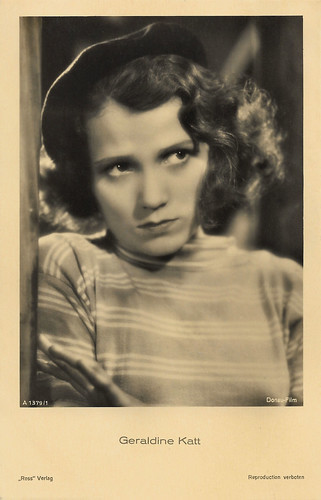
German postcard by Ross Verlag, no. A 1379/1, 1937-1938. Photo: Donau-Film. Geraldine Katt in Florentine (Karel Lamac, 1937).
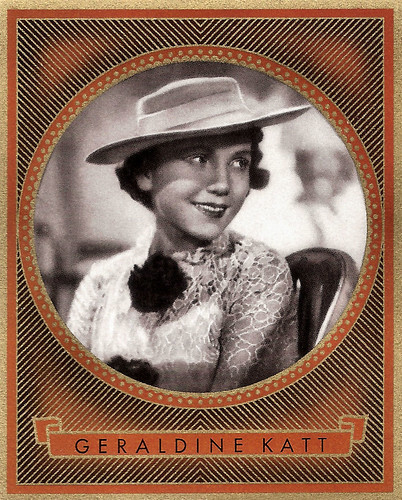
German collectors card in the Bunte Filmbilder series by Greiling-Zigaretten / Ross Verlag, no. 383. Photo: Bavaria. Geraldine Katt in Die Stimme des Herzens/The Voice of the Heart (Karl Heinz Martin, 1937).
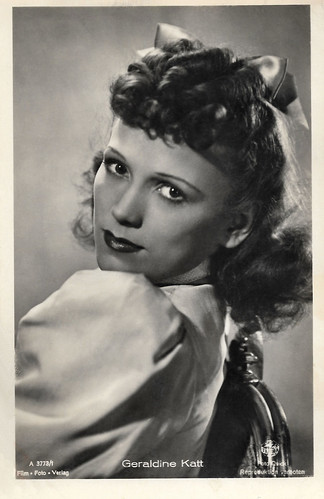
German postcard by Film-Foto-Verlag, no. A 3773/1, 1941-1944. Photo: Quick / Terra. Geraldine Katt in Wenn der junge Wein blüht/When the young wine blooms (Fritz Kirchhoff, 1943).
A film debut at 15
Geraldine Katt was born Geraldine Kattnig in 1920 in Vienna, Austria. She was of Slovenian-Austrian parentage.
Katt trained as an actress at the prestigious Max Reinhardt Seminar. At the Ufa, the only 15-year-old made her film debut in the German drama Das Mädchen Irene/The Girl Irene (Reinhold Schünzel, 1936) starring Lil Dagover and Sabine Peters.
Then she played the female lead as a mischievous-cheeky princess in Die Stimme des Herzens/The Voice of the Heart (Karl Heinz Martin, 1937) opposite star tenor Beniamino Gigli , and the title role in Florentine (Karel Lamac, 1937) with Paul Hörbiger .
She appeared opposite Willy Birgel in the German crime film Der Fall Deruga/The Deruga Case (Fritz Peter Buch, 1938).
Between the various film appearances, Katt was able to establish herself as a theatre actress. She made her stage debut in Vienna in the musical comedy 'Das Frauenparadies' based on the operetta by Robert Stolz.
During the war, she could be seen in the comedy Wenn der junge Wein blüht/When the young wine blooms (Fritz Kirchhoff, 1943) with Henny Porten and Otto Gebühr .
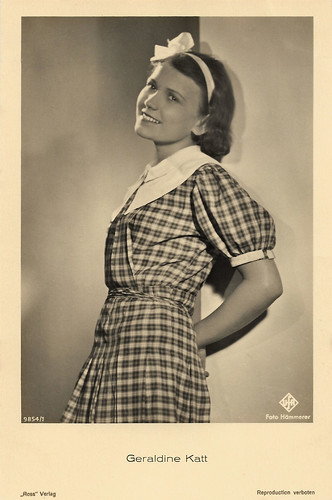
German postcard by Ross Verlag, no. 9854/1, 1935-1936. Photo: Hämmerer / Ufa.
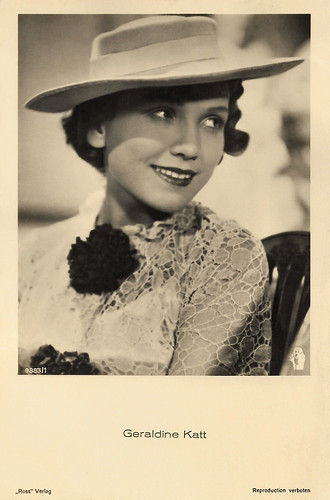
German postcard by Ross Verlag, no. 9883/1, 1935-1936. Photo: Bavaria. Geraldine Katt in Die Stimme des Herzens/The Voice of the Heart (Karl Heinz Martin, 1937).
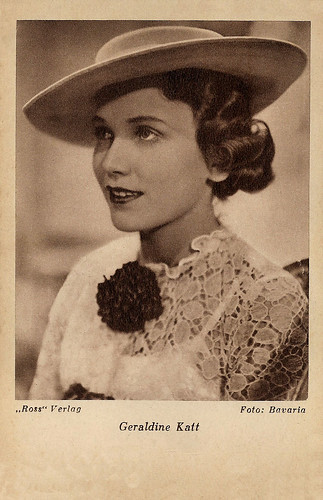
German postcard by Das Programm von Heute, Berlin / Ross Verlag. Photo: Bavaria. Geraldine Katt in Die Stimme des Herzens/The Voice of the Heart (Karlheinz Martin, 1937).
A teacher of theology
After World War II, Geraldine Katt concentrated on stage acting. She played supporting parts in a few Austrian films including the comedies Alles Lüge/All lies (E.W. Emo, 1948) starring Wolf Albach-Retty , and Es lebe das Leben/Long live life! (E.W. Emo, 1949).
Between 1949 and 1951, she performed at the Vienna Volksoper in the operetta 'The beggar student' by Carl Millöcker and in Millöckers 'Gasparone', staged by Oscar Fritz Schuh.
One of her last screen appearances was in the Swiss drama Die Vier im Jeep/Four in a Jeep (Leopold Lindtberg, 1951), a 'Trümer film' (rubble film) starring Ralph Meeker and Viveca Lindfors . The film won the Golden Bear at the 1st Berlin International Film Festival.
Katt had married the theatre critic Anatol in 1940 in Berlin, but she separated again in 1949 from him. In 1952, after marrying the Swiss Hermann Juch, director of the Vienna Volksoper and lawyer, she retired from acting.
In 1964, the couple moved to Switzerland where Juch took over the management of the Zurich Opera House. Katt became a teacher of theology.
Geraldine Katt passed away in 1995. She was 74. A few months earlier Hermann Juch had died in 1995 at the age of 86.
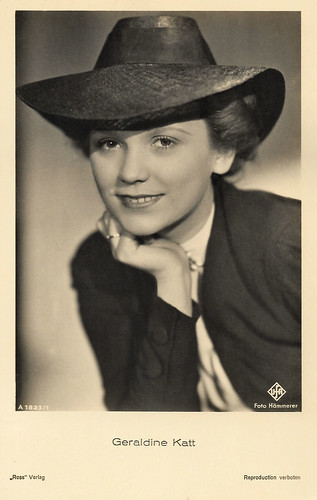
German postcard by Ross Verlag, no. A 1823/1, 1937-1938. Photo: Hämmerer / Ufa.
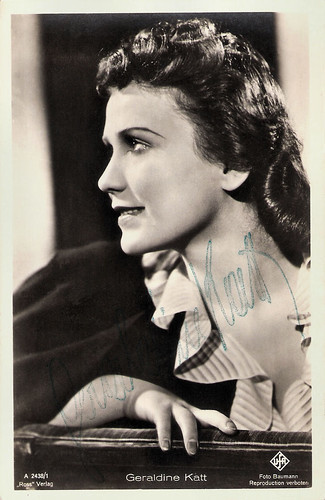
German postcard by Ross Verlag, no. A 2338/1, 1939-1940. Photo: Baumann / Ufa.
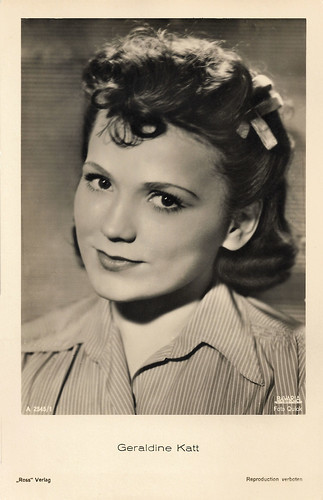
German postcard by Ross Verlag, no. A 2445/1, 1939-1940. Photo: Quick / Bavaria.
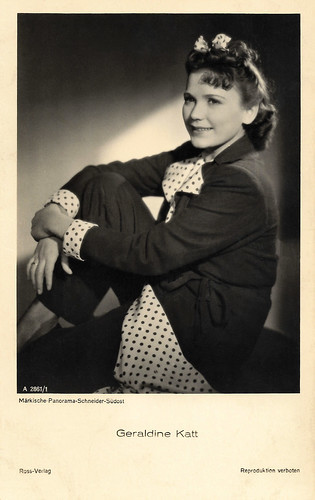
German postcard by Ross Verlag, no. A 2861/1, 1939-1940. Photo: Märkische / Panorama / Schneider / Südost.
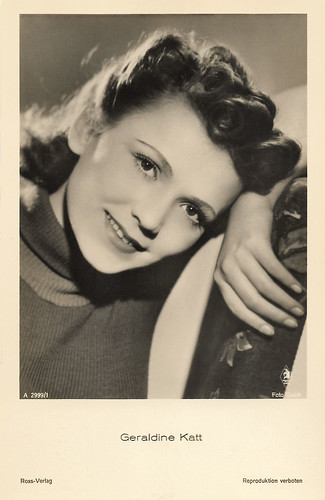
German postcard by Ross Verlag, no. A 2999/1, 1939-1940. Photo: Quick / Bavaria.
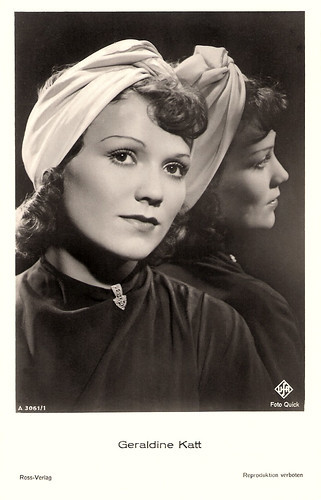
German postcard by Ross Verlag, no. A 3061/1, 1941-1944. Photo: Quick / Ufa.
Sources: Stephanie D'heil (Steffi-line.de - German), Wikipedia (German and English) and .

German postcard by Ross Verlag, no. A 1379/1, 1937-1938. Photo: Donau-Film. Geraldine Katt in Florentine (Karel Lamac, 1937).

German collectors card in the Bunte Filmbilder series by Greiling-Zigaretten / Ross Verlag, no. 383. Photo: Bavaria. Geraldine Katt in Die Stimme des Herzens/The Voice of the Heart (Karl Heinz Martin, 1937).

German postcard by Film-Foto-Verlag, no. A 3773/1, 1941-1944. Photo: Quick / Terra. Geraldine Katt in Wenn der junge Wein blüht/When the young wine blooms (Fritz Kirchhoff, 1943).
A film debut at 15
Geraldine Katt was born Geraldine Kattnig in 1920 in Vienna, Austria. She was of Slovenian-Austrian parentage.
Katt trained as an actress at the prestigious Max Reinhardt Seminar. At the Ufa, the only 15-year-old made her film debut in the German drama Das Mädchen Irene/The Girl Irene (Reinhold Schünzel, 1936) starring Lil Dagover and Sabine Peters.
Then she played the female lead as a mischievous-cheeky princess in Die Stimme des Herzens/The Voice of the Heart (Karl Heinz Martin, 1937) opposite star tenor Beniamino Gigli , and the title role in Florentine (Karel Lamac, 1937) with Paul Hörbiger .
She appeared opposite Willy Birgel in the German crime film Der Fall Deruga/The Deruga Case (Fritz Peter Buch, 1938).
Between the various film appearances, Katt was able to establish herself as a theatre actress. She made her stage debut in Vienna in the musical comedy 'Das Frauenparadies' based on the operetta by Robert Stolz.
During the war, she could be seen in the comedy Wenn der junge Wein blüht/When the young wine blooms (Fritz Kirchhoff, 1943) with Henny Porten and Otto Gebühr .

German postcard by Ross Verlag, no. 9854/1, 1935-1936. Photo: Hämmerer / Ufa.

German postcard by Ross Verlag, no. 9883/1, 1935-1936. Photo: Bavaria. Geraldine Katt in Die Stimme des Herzens/The Voice of the Heart (Karl Heinz Martin, 1937).

German postcard by Das Programm von Heute, Berlin / Ross Verlag. Photo: Bavaria. Geraldine Katt in Die Stimme des Herzens/The Voice of the Heart (Karlheinz Martin, 1937).
A teacher of theology
After World War II, Geraldine Katt concentrated on stage acting. She played supporting parts in a few Austrian films including the comedies Alles Lüge/All lies (E.W. Emo, 1948) starring Wolf Albach-Retty , and Es lebe das Leben/Long live life! (E.W. Emo, 1949).
Between 1949 and 1951, she performed at the Vienna Volksoper in the operetta 'The beggar student' by Carl Millöcker and in Millöckers 'Gasparone', staged by Oscar Fritz Schuh.
One of her last screen appearances was in the Swiss drama Die Vier im Jeep/Four in a Jeep (Leopold Lindtberg, 1951), a 'Trümer film' (rubble film) starring Ralph Meeker and Viveca Lindfors . The film won the Golden Bear at the 1st Berlin International Film Festival.
Katt had married the theatre critic Anatol in 1940 in Berlin, but she separated again in 1949 from him. In 1952, after marrying the Swiss Hermann Juch, director of the Vienna Volksoper and lawyer, she retired from acting.
In 1964, the couple moved to Switzerland where Juch took over the management of the Zurich Opera House. Katt became a teacher of theology.
Geraldine Katt passed away in 1995. She was 74. A few months earlier Hermann Juch had died in 1995 at the age of 86.

German postcard by Ross Verlag, no. A 1823/1, 1937-1938. Photo: Hämmerer / Ufa.

German postcard by Ross Verlag, no. A 2338/1, 1939-1940. Photo: Baumann / Ufa.

German postcard by Ross Verlag, no. A 2445/1, 1939-1940. Photo: Quick / Bavaria.

German postcard by Ross Verlag, no. A 2861/1, 1939-1940. Photo: Märkische / Panorama / Schneider / Südost.

German postcard by Ross Verlag, no. A 2999/1, 1939-1940. Photo: Quick / Bavaria.

German postcard by Ross Verlag, no. A 3061/1, 1941-1944. Photo: Quick / Ufa.
Sources: Stephanie D'heil (Steffi-line.de - German), Wikipedia (German and English) and .
Published on January 07, 2020 22:00
January 6, 2020
Robin Hood (1973)
The twenty-first Disney animated feature film Robin Hood (Wolfgang Reitherman, 1973) is an imaginative version of the Robin Hood legend. Fun and romance abound as the swashbuckling hero of Sherwood Forest and his valiant sidekick Little John plot one daring adventure after another to outwit the greedy prince John.
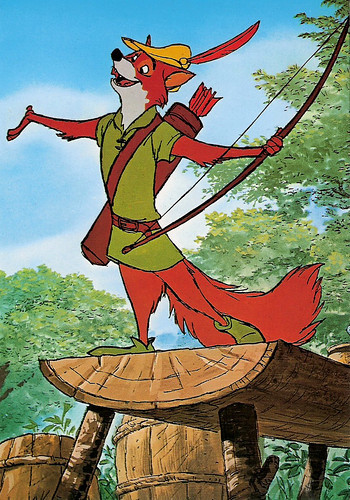
Italian postcard by Grafiche Biondetti S.R.L., Verona. Image: Disney. Publicity still for Robin Hood (Wolfgang Reitherman, 1973).
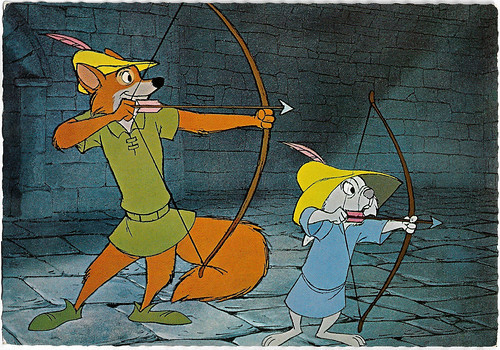
Belgian postcard by Editions Corna, Bruxelles (Brussels), no. 3303. Image: Walt Disney Productions. Publicity still for Robin Hood (Wolfgang Reitherman, 1973).
OutlawThe idea to adapt 'Robin Hood' into an animated feature dated back to Walt Disney's interest in the tale of Reynard the Fox during his first full-length feature production, Snow White and the Seven Dwarfs (David Hand a.o., 1937).
The idea was repeatedly shelved until writer and production designer Ken Anderson incorporated ideas from it in a pitch of the legend of Robin Hood using anthropomorphic animals rather than people during Disney's previous production of The Aristocats (Wolfgang Reitherman, 1970).
Robin Hood (Wolfgang Reitherman, 1973) is narrated by the rooster Alan-a-Dale, who explains that Robin Hood and Little John live in Sherwood Forest, robbing from the rich and giving to the poor townsfolk of Nottingham. Robin and Little John happen upon the royal entourage which is taking Prince John and his counsellor, Sir Hiss, to Nottingham in order to tax the people there.
Disguised as female fortune-tellers, Robin and Little John effectively steal from Prince John all the gold they can carry and run off into the forest, leaving Prince John sucking his thumb in humiliation.
In Nottingham, Robin uses Friar Tuck to smuggle the stolen gold back to the peasants. Later Robin sees Maid Marian, she and Robin had once been sweethearts as children, but were forced to part ways when she moved to London. Since Robin is an outlaw he waits for marriage. Marian is mistaken when she thinks he has forgotten her: Robin can't stop thinking about her.
Seething with rage, that Robin is winning, John triples the taxes, making the bleak situation in Nottingham even worse. One night, Robin Hood, disguised again as the beggar, learns that Friar Tuck is in jail and will rescue him, save Nottingham once and for all and give Prince John the justice that has been coming to him for a long time...
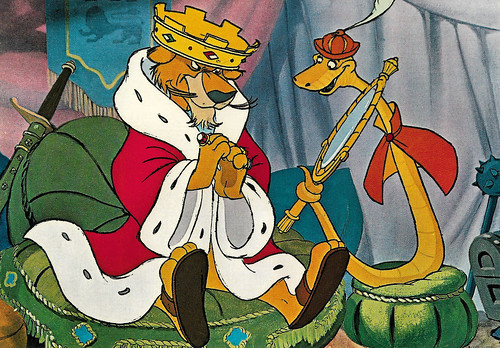
French postcard in the series Le Monde merveilleux de Walt Disney by Editions Kroma, Caissargues, no. 233. Image: Walt Disney Productions. Publicity still for Robin Hood (Wolfgang Reitherman, 1973).
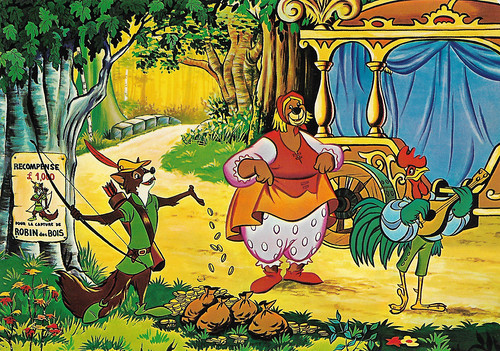
French postcard by G. Picard, Paris, no. WD 1/6. Image: Disney. Publicity still for Robin Hood (Wolfgang Reitherman, 1973).
Great characters with witty and smart dialogues
Robin Hood (Wolfgang Reitherman, 1973) is generally considered to be one of the weakest Disney animated classics, but I totally disagree.
Yes, this version of Robin Hood has animals in the roles of the characters, but it works superbly! Robin Hood as a clever fox is a natural choice. And naturally, Maid Marian is a vixen. Prince John and King Richard as lions are also logical choices.
But John is a mane-less lion, who starts sucking his thumb whenever anyone mentions his mother. He is silly, but with a truly evil undercurrent. The Sheriff of Nottingham is also deliciously nasty ("Upsy-daisy"), Other hilarious characters are the vultures Trigger, and Nutsy, and Sir Hiss, the snake. They provide the delicious humour to the film.
Sir Hiss is smarter than any of the other bad guys, but the humour with him is that Prince John never believes him until it's too late, and abuses him afterwards. Trigger's 'old Betsy' (a crossbow) provides plenty of laughs, especially when it goes off. And Nutsy is so stupid he says "One o'clock and all's well!" when it's three o'clock, and when told to set his brain ahead a couple hours, he doesn't know if he has to add or subtract two hours.
Apart from the great characters and their witty and smart dialogues, the film has beautiful background artwork e especially in the love scene, and the music is also good, with the hard and gritty song 'Not in Nottingham' as a highlight.
Robin Hood was a box office hit at the time and it was initially received with positive reviews from film critics who praised the voice cast, animation, and humour, but its critical reception became gradually mixed since its release and recycled scenes of animation have been noted. But despite these flaws, Robin Hood is still a very entertaining Disney classic.
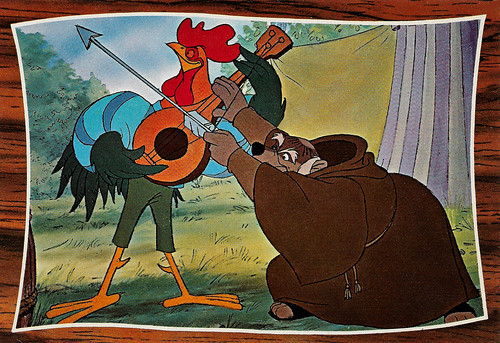
Belgian postcard by Editions Corna, Bruxelles (Brussels), no. 3303. Image: Walt Disney Productions. Publicity still for Robin Hood (Wolfgang Reitherman, 1973).
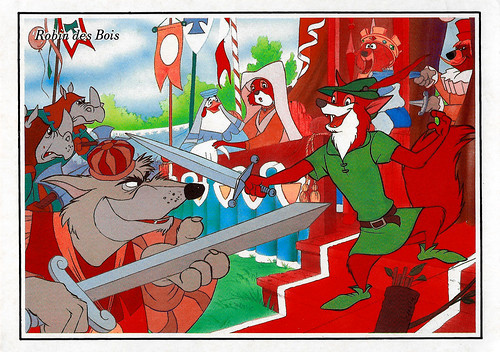
French postcard in the Les Dessins de Walt Disney series by MD, no. D 430. Image: Disney. Publicity still for Robin Hood (Wolfgang Reitherman, 1973).
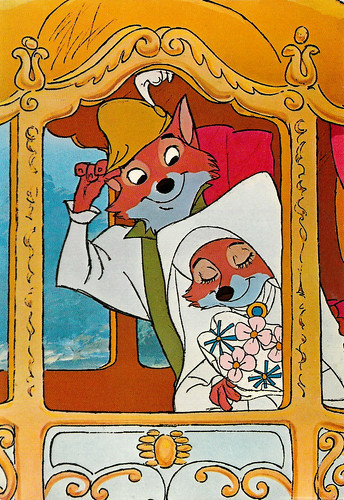
French postcard in the series Le Monde merveilleux de Walt Disney by Editions Kroma, Caissargues, no. 235. Image: Walt Disney Productions. Publicity still for Robin Hood (Wolfgang Reitherman, 1973).
Sources: Wikipedia and IMDb.

Italian postcard by Grafiche Biondetti S.R.L., Verona. Image: Disney. Publicity still for Robin Hood (Wolfgang Reitherman, 1973).

Belgian postcard by Editions Corna, Bruxelles (Brussels), no. 3303. Image: Walt Disney Productions. Publicity still for Robin Hood (Wolfgang Reitherman, 1973).
OutlawThe idea to adapt 'Robin Hood' into an animated feature dated back to Walt Disney's interest in the tale of Reynard the Fox during his first full-length feature production, Snow White and the Seven Dwarfs (David Hand a.o., 1937).
The idea was repeatedly shelved until writer and production designer Ken Anderson incorporated ideas from it in a pitch of the legend of Robin Hood using anthropomorphic animals rather than people during Disney's previous production of The Aristocats (Wolfgang Reitherman, 1970).
Robin Hood (Wolfgang Reitherman, 1973) is narrated by the rooster Alan-a-Dale, who explains that Robin Hood and Little John live in Sherwood Forest, robbing from the rich and giving to the poor townsfolk of Nottingham. Robin and Little John happen upon the royal entourage which is taking Prince John and his counsellor, Sir Hiss, to Nottingham in order to tax the people there.
Disguised as female fortune-tellers, Robin and Little John effectively steal from Prince John all the gold they can carry and run off into the forest, leaving Prince John sucking his thumb in humiliation.
In Nottingham, Robin uses Friar Tuck to smuggle the stolen gold back to the peasants. Later Robin sees Maid Marian, she and Robin had once been sweethearts as children, but were forced to part ways when she moved to London. Since Robin is an outlaw he waits for marriage. Marian is mistaken when she thinks he has forgotten her: Robin can't stop thinking about her.
Seething with rage, that Robin is winning, John triples the taxes, making the bleak situation in Nottingham even worse. One night, Robin Hood, disguised again as the beggar, learns that Friar Tuck is in jail and will rescue him, save Nottingham once and for all and give Prince John the justice that has been coming to him for a long time...

French postcard in the series Le Monde merveilleux de Walt Disney by Editions Kroma, Caissargues, no. 233. Image: Walt Disney Productions. Publicity still for Robin Hood (Wolfgang Reitherman, 1973).

French postcard by G. Picard, Paris, no. WD 1/6. Image: Disney. Publicity still for Robin Hood (Wolfgang Reitherman, 1973).
Great characters with witty and smart dialogues
Robin Hood (Wolfgang Reitherman, 1973) is generally considered to be one of the weakest Disney animated classics, but I totally disagree.
Yes, this version of Robin Hood has animals in the roles of the characters, but it works superbly! Robin Hood as a clever fox is a natural choice. And naturally, Maid Marian is a vixen. Prince John and King Richard as lions are also logical choices.
But John is a mane-less lion, who starts sucking his thumb whenever anyone mentions his mother. He is silly, but with a truly evil undercurrent. The Sheriff of Nottingham is also deliciously nasty ("Upsy-daisy"), Other hilarious characters are the vultures Trigger, and Nutsy, and Sir Hiss, the snake. They provide the delicious humour to the film.
Sir Hiss is smarter than any of the other bad guys, but the humour with him is that Prince John never believes him until it's too late, and abuses him afterwards. Trigger's 'old Betsy' (a crossbow) provides plenty of laughs, especially when it goes off. And Nutsy is so stupid he says "One o'clock and all's well!" when it's three o'clock, and when told to set his brain ahead a couple hours, he doesn't know if he has to add or subtract two hours.
Apart from the great characters and their witty and smart dialogues, the film has beautiful background artwork e especially in the love scene, and the music is also good, with the hard and gritty song 'Not in Nottingham' as a highlight.
Robin Hood was a box office hit at the time and it was initially received with positive reviews from film critics who praised the voice cast, animation, and humour, but its critical reception became gradually mixed since its release and recycled scenes of animation have been noted. But despite these flaws, Robin Hood is still a very entertaining Disney classic.

Belgian postcard by Editions Corna, Bruxelles (Brussels), no. 3303. Image: Walt Disney Productions. Publicity still for Robin Hood (Wolfgang Reitherman, 1973).

French postcard in the Les Dessins de Walt Disney series by MD, no. D 430. Image: Disney. Publicity still for Robin Hood (Wolfgang Reitherman, 1973).

French postcard in the series Le Monde merveilleux de Walt Disney by Editions Kroma, Caissargues, no. 235. Image: Walt Disney Productions. Publicity still for Robin Hood (Wolfgang Reitherman, 1973).
Sources: Wikipedia and IMDb.
Published on January 06, 2020 22:00
January 5, 2020
Richard Dix
American film actor Richard Dix (1893–1949) achieved popularity in both silent and sound film, first as the rugged and stalwart hero in countless Westerns, then dramatic features such as the Cecil B. DeMille's The Ten Commandments (1923). After his years of silent film at Paramount, and thanks to his deep voice and commanding presence, he became a well-known star at RKO in the 1930s. He was nominated for the Academy Award for Best Actor for his lead role in the Best Picture-winning epic, Cimarron (1931).
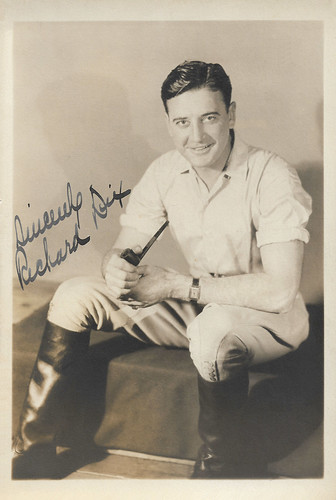
Vintage photo. Signature: Sincerely Richard Dix.
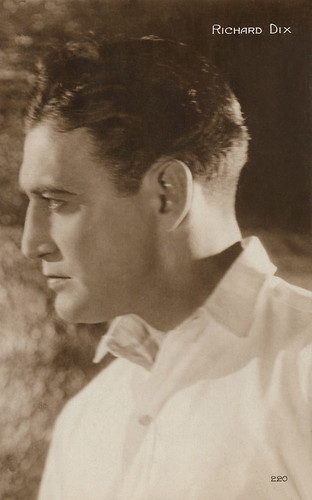
French postcard by Editions Cinémagazine, no. 220.
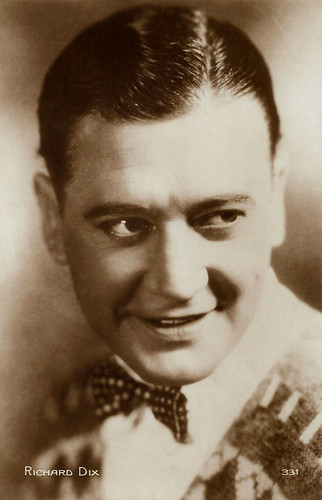
French postcard by Cinémagazine-Edition, Paris, no. 331.
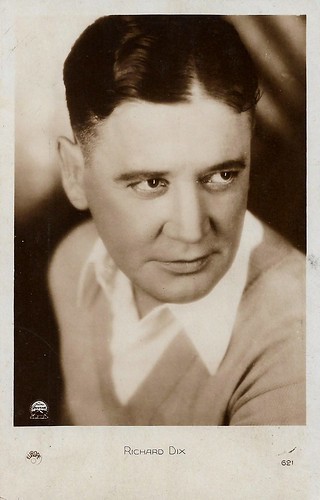
French postcard by Europe, no. 21.
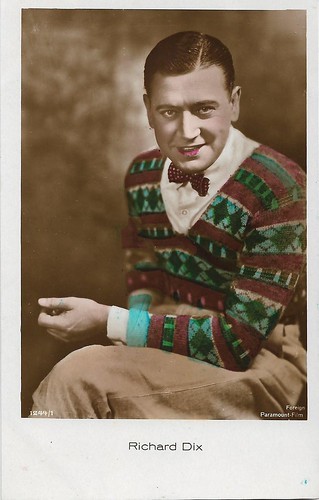
German postcard by Ross Verlag, Foreign, no. 1244/1, 1927-1928. Photo: Paramount.
Rugged good looks and dark features
Richard Dix was born Ernest Carlton Brimmer in 1893, in St. Paul, Minnesota. There he was educated, and at the desires of his father, studied to be a surgeon.
His obvious acting talent in his school dramatic club led him to leading roles in most of the school plays. Dix excelled in sports, especially football and baseball. These skills would serve him well in the vigorous film roles he would go on to play.
After a year at the University of Minnesota he took a position at a bank, spending his evenings training for the stage. His professional start was with a local stock company, and this led to similar work in New York.
The death of his father left him with a mother and sister to support. He went to Los Angeles, and changed his name to Dix. He became leading man for the Morosco Stock Company and his success there got him a contract with Paramount Pictures. His rugged good looks and dark features made him a popular player in Westerns.
Dix's best-remembered early role was in Cecil B. DeMille's silent version of the religious epic film The Ten Commandments (1923). Lauded for its immense and stupendous scenes, use of Technicolor process, and parting of the Red Sea sequence, the expensive film proved to be a box-office hit upon release.
His athletic ability led to his starring role opposite Jean Arthur in Paramount's Warming Up (Fred C. Newmeyer, 1928), a baseball story and also the studio's first feature with synchronised score and sound effects. His deep voice and commanding presence were perfectly suited for the talkies, and he was signed by RKO Radio Pictures in 1929.
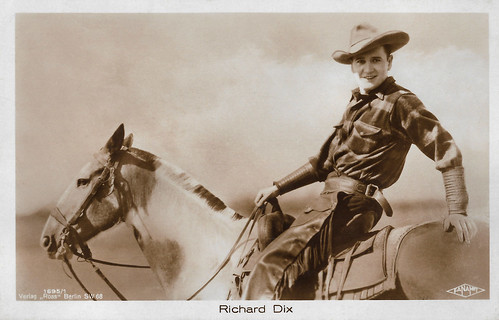
German postcard by Ross Verlag, no. 1685/1, 1927-1928. Photo: Fanamet. Richard Dix in Womanhandled (Gregory La Cava, 1925).
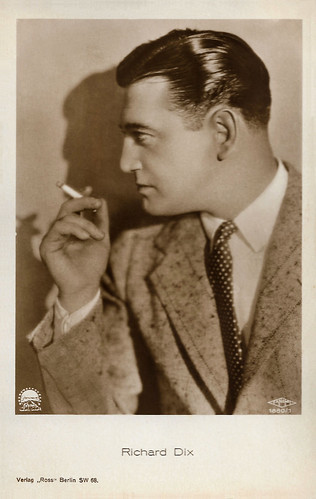
German postcard by Ross Verlag, no. 1880/1, 1927-1928. Photo: Paramount / Fanamet.
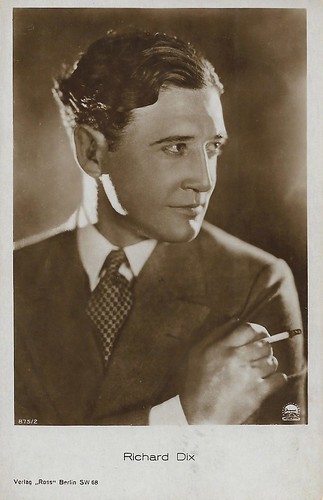
German postcard by Ross Verlag, no. 875/2, 1925-1926. Photo: Paramount.
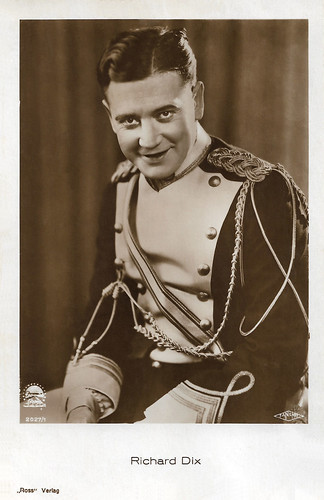
German postcard by Ross Verlag, no. 2027/1, 1927-1928. Photo: Paramount / Fanamet. Richard Dix in Moran of the Marines (Frank R. Strayer, 1928).
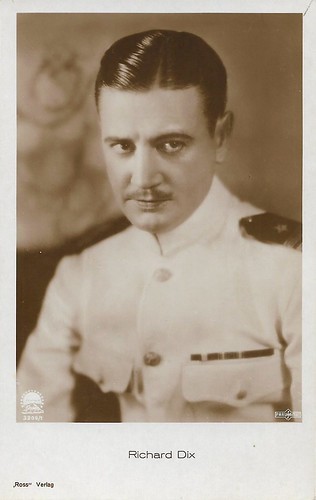
German postcard by Ross Verlag, no. 3206/1, 1928-1929. Photo: Parufamet / Paramount. Richard Dix in The Wheel of Life (Victor Schertzinger, 1929).
A big box-office draw at RKO
Richard Dix was a major leading man at RKO Radio Pictures from 1929 through 1943. Dix scored an early triumph in the all-talking mystery drama, Seven Keys to Baldpate (Reginald Barker, 1929) with Margaret Livingston .
In 1931 he was nominated for a Best Actor Oscar for his masterful performance in Cimarron (Wesley Ruggles, 1931) opposite Irene Dunne. Cimarron, based on the popular novel by Edna Ferber, took the Best Picture award. Epic in scope, spanning forty years from 1889 to 1929, it was a critical success, although it did not recoup its production costs during its initial run in 1931.
Throughout the 1930s Dix would be a big box-office draw at RKO, appearing in mystery thrillers, potboilers, Westerns and programmers. A memorable role for Dix was in the British futuristic film The Tunnel (Maurice Elvey, 1935) opposite Leslie Banks . The film, produced at a time when the threat of war loomed in Europe, emphasised international cooperation between the United States and the United Kingdom.
In 1941, Dix played Wild Bill Hickok in the Western Badlands of Dakota (Alfred E. Green, 1941) opposite Robert Stack, and portrayed former gunslinger Wyatt Earp the following year in another Western, Tombstone, the Town Too Tough to Die (William C. McGann, 1942), featuring Edgar Buchanan as Curly Bill Brocious. Dix also starred as the homicidal Captain Stone in the Val Lewton production of The Ghost Ship (Mark Robson, 1943).
In 1944, Dix starred in the mystery Film Noir The Whistler (William Castle, 1944), co- starring Gloria Stuart and J. Carrol Naish. Based on the radio drama 'The Whistler', it was the first of Columbia Pictures' eight 'Whistler' films in which Dix played a different character each time. (He did not play the 'Whistler', who was an unseen narrator.) By the time Dix started the series, he was a heavy drinker and subject to hiccups. He retired from films in 1947.
He first married Winifred Coe in 1931. They had a daughter, Martha Mary Ellen, and then divorced in 1933. He then married Virginia Webster in 1934. They had twin boys, Richard Jr. and Robert Dix and an adopted daughter, Sara Sue.
After years of fighting alcoholism, Richard Dix suffered a serious heart attack in 1949, while on a train from New York to Los Angeles. He died a week later in Los Angeles at the age of 56. Dix was interred at Forest Lawn (Glendale), Glendale, California, in the Whispering Pines section, lot #2387. Dix has a star on the Hollywood Walk of Fame in the Motion Pictures section at 1610 Vine Street. It was dedicated in 1960.
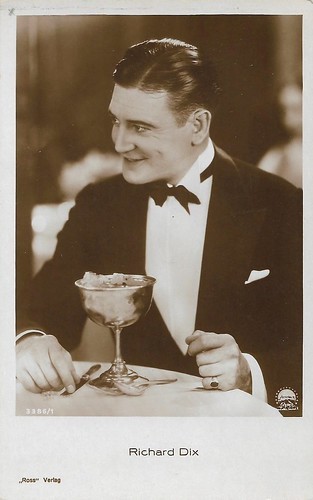
German postcard by Ross Verlag, no. 3386/1, 1928-1929. Photo: Paramount.
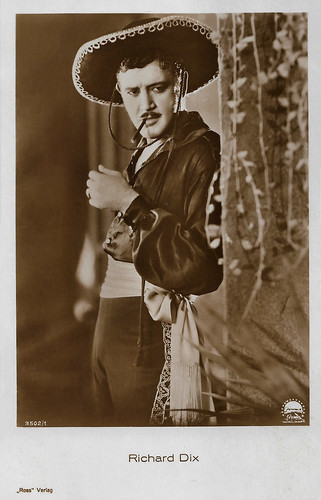
German postcard by Ross Verlag, no. 3502/1, 1928-1929. Photo: Paramount. Richard Dix in The Gay Defender (Gregory La Cava, 1927).
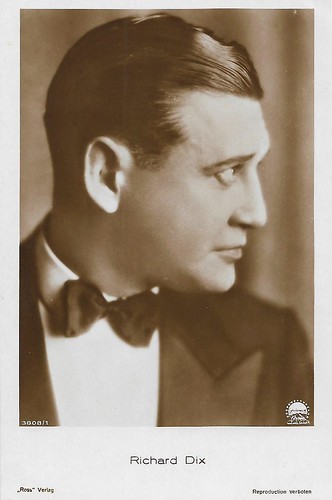
German postcard by Ross Verlag, no. 3808/1, 1928-1929. Photo: Paramount.
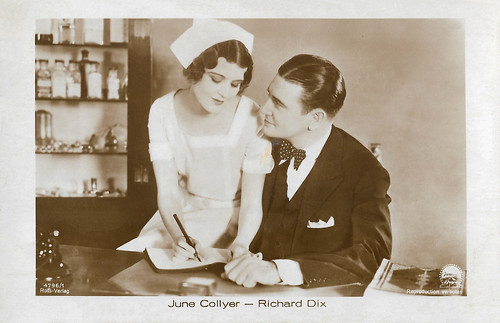
German postcard by Ross Verlag, no. 4796/1, 1929-1930. Photo: Paramount. June Collyer and Richard Dix in The Love Doctor (Melville W. Brown, 1929).
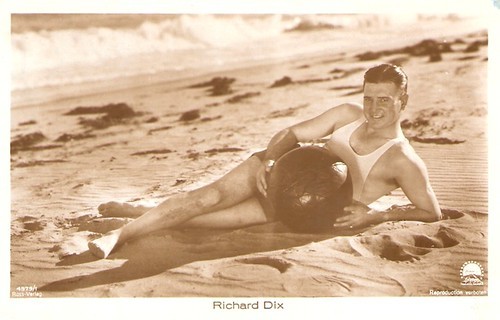
German postcard by Ross Verlag, no. 4979/1, 1929-1930. Photo: Paramount. Card mailed in Rotterdam, 1931.
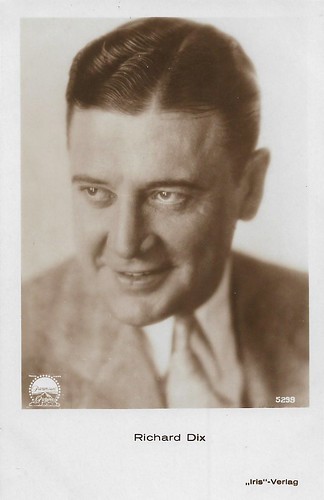
Austrian postcard by Iris Verlag, no. 5299. Photo: Paramount.
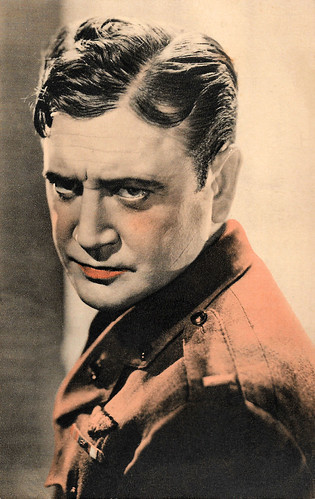
British postcard in the Film Picture Stories Star Series, no. 4. Photo: Radio Pictures.
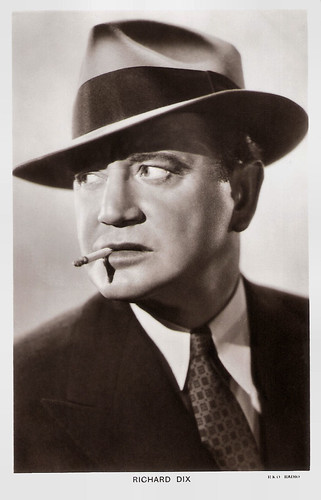
British postcard in the Picturegoer Series, London, no. 1343. Photo: RKO Radio Pictures.
Sources: (IMDb), Wikipedia and .

Vintage photo. Signature: Sincerely Richard Dix.

French postcard by Editions Cinémagazine, no. 220.

French postcard by Cinémagazine-Edition, Paris, no. 331.

French postcard by Europe, no. 21.

German postcard by Ross Verlag, Foreign, no. 1244/1, 1927-1928. Photo: Paramount.
Rugged good looks and dark features
Richard Dix was born Ernest Carlton Brimmer in 1893, in St. Paul, Minnesota. There he was educated, and at the desires of his father, studied to be a surgeon.
His obvious acting talent in his school dramatic club led him to leading roles in most of the school plays. Dix excelled in sports, especially football and baseball. These skills would serve him well in the vigorous film roles he would go on to play.
After a year at the University of Minnesota he took a position at a bank, spending his evenings training for the stage. His professional start was with a local stock company, and this led to similar work in New York.
The death of his father left him with a mother and sister to support. He went to Los Angeles, and changed his name to Dix. He became leading man for the Morosco Stock Company and his success there got him a contract with Paramount Pictures. His rugged good looks and dark features made him a popular player in Westerns.
Dix's best-remembered early role was in Cecil B. DeMille's silent version of the religious epic film The Ten Commandments (1923). Lauded for its immense and stupendous scenes, use of Technicolor process, and parting of the Red Sea sequence, the expensive film proved to be a box-office hit upon release.
His athletic ability led to his starring role opposite Jean Arthur in Paramount's Warming Up (Fred C. Newmeyer, 1928), a baseball story and also the studio's first feature with synchronised score and sound effects. His deep voice and commanding presence were perfectly suited for the talkies, and he was signed by RKO Radio Pictures in 1929.

German postcard by Ross Verlag, no. 1685/1, 1927-1928. Photo: Fanamet. Richard Dix in Womanhandled (Gregory La Cava, 1925).

German postcard by Ross Verlag, no. 1880/1, 1927-1928. Photo: Paramount / Fanamet.

German postcard by Ross Verlag, no. 875/2, 1925-1926. Photo: Paramount.

German postcard by Ross Verlag, no. 2027/1, 1927-1928. Photo: Paramount / Fanamet. Richard Dix in Moran of the Marines (Frank R. Strayer, 1928).

German postcard by Ross Verlag, no. 3206/1, 1928-1929. Photo: Parufamet / Paramount. Richard Dix in The Wheel of Life (Victor Schertzinger, 1929).
A big box-office draw at RKO
Richard Dix was a major leading man at RKO Radio Pictures from 1929 through 1943. Dix scored an early triumph in the all-talking mystery drama, Seven Keys to Baldpate (Reginald Barker, 1929) with Margaret Livingston .
In 1931 he was nominated for a Best Actor Oscar for his masterful performance in Cimarron (Wesley Ruggles, 1931) opposite Irene Dunne. Cimarron, based on the popular novel by Edna Ferber, took the Best Picture award. Epic in scope, spanning forty years from 1889 to 1929, it was a critical success, although it did not recoup its production costs during its initial run in 1931.
Throughout the 1930s Dix would be a big box-office draw at RKO, appearing in mystery thrillers, potboilers, Westerns and programmers. A memorable role for Dix was in the British futuristic film The Tunnel (Maurice Elvey, 1935) opposite Leslie Banks . The film, produced at a time when the threat of war loomed in Europe, emphasised international cooperation between the United States and the United Kingdom.
In 1941, Dix played Wild Bill Hickok in the Western Badlands of Dakota (Alfred E. Green, 1941) opposite Robert Stack, and portrayed former gunslinger Wyatt Earp the following year in another Western, Tombstone, the Town Too Tough to Die (William C. McGann, 1942), featuring Edgar Buchanan as Curly Bill Brocious. Dix also starred as the homicidal Captain Stone in the Val Lewton production of The Ghost Ship (Mark Robson, 1943).
In 1944, Dix starred in the mystery Film Noir The Whistler (William Castle, 1944), co- starring Gloria Stuart and J. Carrol Naish. Based on the radio drama 'The Whistler', it was the first of Columbia Pictures' eight 'Whistler' films in which Dix played a different character each time. (He did not play the 'Whistler', who was an unseen narrator.) By the time Dix started the series, he was a heavy drinker and subject to hiccups. He retired from films in 1947.
He first married Winifred Coe in 1931. They had a daughter, Martha Mary Ellen, and then divorced in 1933. He then married Virginia Webster in 1934. They had twin boys, Richard Jr. and Robert Dix and an adopted daughter, Sara Sue.
After years of fighting alcoholism, Richard Dix suffered a serious heart attack in 1949, while on a train from New York to Los Angeles. He died a week later in Los Angeles at the age of 56. Dix was interred at Forest Lawn (Glendale), Glendale, California, in the Whispering Pines section, lot #2387. Dix has a star on the Hollywood Walk of Fame in the Motion Pictures section at 1610 Vine Street. It was dedicated in 1960.

German postcard by Ross Verlag, no. 3386/1, 1928-1929. Photo: Paramount.

German postcard by Ross Verlag, no. 3502/1, 1928-1929. Photo: Paramount. Richard Dix in The Gay Defender (Gregory La Cava, 1927).

German postcard by Ross Verlag, no. 3808/1, 1928-1929. Photo: Paramount.

German postcard by Ross Verlag, no. 4796/1, 1929-1930. Photo: Paramount. June Collyer and Richard Dix in The Love Doctor (Melville W. Brown, 1929).

German postcard by Ross Verlag, no. 4979/1, 1929-1930. Photo: Paramount. Card mailed in Rotterdam, 1931.

Austrian postcard by Iris Verlag, no. 5299. Photo: Paramount.

British postcard in the Film Picture Stories Star Series, no. 4. Photo: Radio Pictures.

British postcard in the Picturegoer Series, London, no. 1343. Photo: RKO Radio Pictures.
Sources: (IMDb), Wikipedia and .
Published on January 05, 2020 22:00
January 4, 2020
Milan Beli (1931-2019)
Serbian actor Milan Beli or Milan Bosiljcic has passed away last Tuesday, 31 December 2019, at the age of 88. He was best known as the villain in such East-German films as the Eastern Tecumseh (1972), Das Licht auf dem Galgen (1976) and Das Ding im Schloß (1979). He appeared in more than 50 European films.
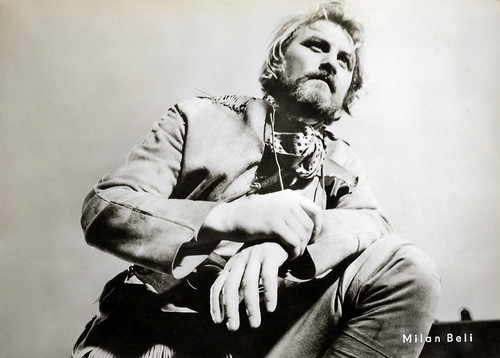
East-German postcard by VEB Progress Film-Vertrieb, Berlin, no. 42/72. Photo: Schütz / DEFA. Milan Beli in Tecumseh (Hans Kratzert, 1972).
Villain in Red Westerns
Milan Beli was born Milan Bosiljciv-Berli in 1931 in Konjane near Uzice, Kingdom of Yugoslavia (now Serbia).
After finishing school, Bosiljcic began to study sports in Belgrade. During his studies, he made his first contacts with the cinema. At the time, many international adventure films and Westerns were produced in Yugoslavia, and the extras were often students from the Belgrade Sport University, such as Gojko Mitić .
In 1957 Milan obtained his first small film role in the French-Yugoslav adventure film Burlak. He also appeared in such films as the Yugoslavian-Italian historical action film Dubrowsky/Il vendicatore (William Dieterle, 1958), based on the novel 'Dubrovsky' by Alexander Pushkin, starring John Forsythe and Rosanna Schiaffino , La tempesta/Tempest (Alberto Lattuada, 1958) starring Silvana Mangano and Van Heflin, and La Steppa/The Steppe (Alberto Lattuada, 1962).
The Italian director Alberto Lattuada recommended that he would attend an acting school in Rome, which he did for two years. Bosiljcic, who spoke English, German, Italian and French in addition to his mother tongue, then accepted offers in the Karl May film Winnetou und sein Freund Old Firehand/Winnetou and his friend Old Firehand (Alfred Vohrer, 1966) starring Pierre Brice and Rod Cameron, and in Die Nibelungen Teil 1: Siegfried von Xanten/Siegfried (Harald Reinl, 1966) and Die Nibelungen Teil 2: Kriemhilds Rache/Whom the Gods Wish to Destroy 2 (Harald Reinl, 1967).
From 1968 on, Bosiljciv received offers from the DEFA, the state-owned East German studio. He worked as a choreographer for the dance scenes in Konrad Wolf's epic Goya – oder der arge Weg der Erkenntnis/Goya or the Hard Way to Enlightenment (1971) featuring Donatas Banionis .
For the DEFA he would often appear in the Easterns (or Red Westerns), the East-European Indian films. DEFA officials changed his surname for simplicity into 'Milan Beli', and his role as villain in the Eastern Tecumseh (Hans Kratzert, 1972), starring Gojko Mitić and Annekathrin Bürger, lead to his breakthrough. The film depicts the life of the Native American leader Tecumseh (1768–1813). |n line with the policies of Communist East Germany, the film attempted to present a more critical, but also more realistic view of American expansion to the West than it was represented by Hollywood.
Next, Beli appeared in a leading role opposite Mitić in the Eastern Apachen/Apaches (Gottfried Kolditz, 1973), loosely based on the legend of heroic Apache warrior Ulzana. It was another success. In Yugoslavia he played a part in the trashy Nazi-sexploitation comedy Eine Armee Gretchen/She Devils of the SS (Erwin C. Dietrich, 1973), a Swiss production with Karin Heske and Carl Möhner .
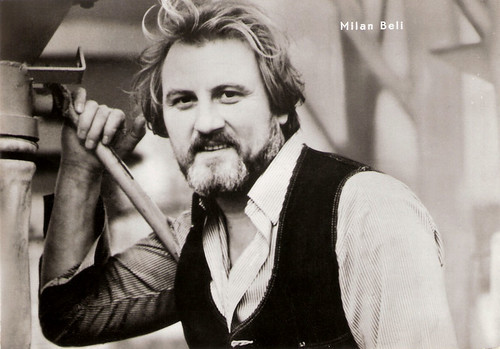
East-German postcard by VEB Progress Film-Vertrieb, Berlin, no. 107/76. Photo: Blasig.
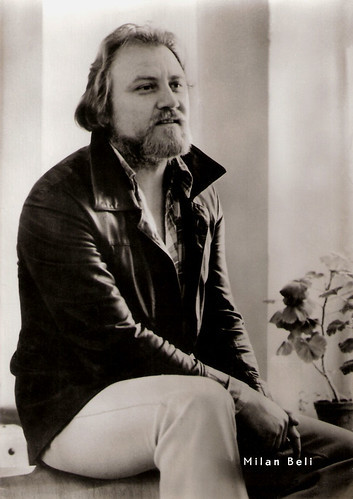
East-German postcard by VEB Progress Film-Vertrieb, Berlin, no. 17/79. Photo: Klaunick.
The Last Eastern
Back in East-Germany, Milan Beli played in the action film Das Licht auf dem Galgen/The Light on the Gallows (Helmut Nitzschke, 1976) about slavery. The film, filmed in Cuba and Bulgaria, was a flop. That year, he appeared in his 50th film, the East-German Sci-Fi film Im Staub der Sterne/In the Dust of the Stars (Gottfried Kolditz, 1976) starring Czech actress Jana Brejchová . Martin Hafer at IMDb : "In many ways, the movie really is bad but most of these ways actually make it rather fun to watch. And, in a few ways, the film actually was pretty good--the plot, after a while, actually turned out to be pretty good."
Beli remained working in the East-German cinema. In 1978, he appeared in the East-German-Soviet coproduction Ich will euch sehen/I Want to See You (János Veiczi, 1978), starring Walter Plathe. Next, he appeared in another Sci-Fi-film Das Ding im Schloß/The Thing in the Castle (Gottfried Kolditz, 1979) starring Erwin Geschonneck and Vlastimil Brodský. He had a small part in the GDR Krimi Für Mord kein Beweis/No evidence of murder (Konrad Petzold, 1979), starring Winfried Glatzeder .
His final film was once more an Eastern starring Gojko Mitić , Der Scout/The Scout (Dshamjangijn Buntar, Konrad Petzold, 1983). The film is based on real events. At the end of the 1870s the fights against the Sioux were over, and the US-Army started putting the Indian tribes living to the West of the Rocky Mountains into reservations. The horses of the Nez Perce Indians are taken away by the US army, hoping the Indians will stay in a reservation. White Feather ( Gojko Mitić ) pretends he wants to serve the soldiers as a scout, but he intends to bring the horses back to his people.
This excellent film was the last of the series of Easterns by the DEFA. Milan Beli returned to Serbia, where he continued his career in films and on TV as Milan Bosiljcic(-Beli). Most recently, he played a Hungarian king in an episode of the television series Nemanjici-radjanje kraljevine/The Nemanjic Dynasty: The Birth of the Kingdom (Marko Marinkovic, 2018), about one of the most influential Serbian dynasties of the middle ages.
Milan Bosiljcic died in 2019 of natural causes in Belgrade, Serbia at the age of 88. His son Milan Bosiljcic (1982) is also an actor and dancer and is well known in Serbia.
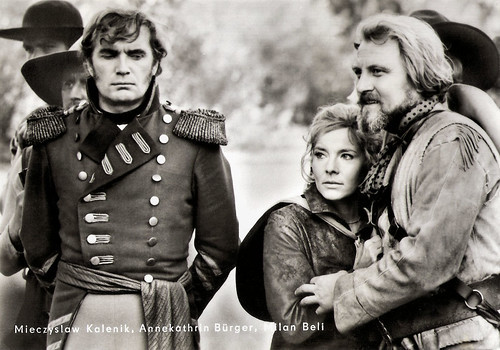
East-German postcard by VEB Progress Film-Vertrieb, Berlin, no. 50/72. Photo: DEFA / Zilmmer. Mieczyslaw Kalenik, Annekathrin Bürger and Milan Beli in Tecumseh (Hans Kratzert, 1972).
Sources: Les gens du Cinema (French), Wikipedia (German) and IMDb, which has two lemmas with different info on him: and

East-German postcard by VEB Progress Film-Vertrieb, Berlin, no. 42/72. Photo: Schütz / DEFA. Milan Beli in Tecumseh (Hans Kratzert, 1972).
Villain in Red Westerns
Milan Beli was born Milan Bosiljciv-Berli in 1931 in Konjane near Uzice, Kingdom of Yugoslavia (now Serbia).
After finishing school, Bosiljcic began to study sports in Belgrade. During his studies, he made his first contacts with the cinema. At the time, many international adventure films and Westerns were produced in Yugoslavia, and the extras were often students from the Belgrade Sport University, such as Gojko Mitić .
In 1957 Milan obtained his first small film role in the French-Yugoslav adventure film Burlak. He also appeared in such films as the Yugoslavian-Italian historical action film Dubrowsky/Il vendicatore (William Dieterle, 1958), based on the novel 'Dubrovsky' by Alexander Pushkin, starring John Forsythe and Rosanna Schiaffino , La tempesta/Tempest (Alberto Lattuada, 1958) starring Silvana Mangano and Van Heflin, and La Steppa/The Steppe (Alberto Lattuada, 1962).
The Italian director Alberto Lattuada recommended that he would attend an acting school in Rome, which he did for two years. Bosiljcic, who spoke English, German, Italian and French in addition to his mother tongue, then accepted offers in the Karl May film Winnetou und sein Freund Old Firehand/Winnetou and his friend Old Firehand (Alfred Vohrer, 1966) starring Pierre Brice and Rod Cameron, and in Die Nibelungen Teil 1: Siegfried von Xanten/Siegfried (Harald Reinl, 1966) and Die Nibelungen Teil 2: Kriemhilds Rache/Whom the Gods Wish to Destroy 2 (Harald Reinl, 1967).
From 1968 on, Bosiljciv received offers from the DEFA, the state-owned East German studio. He worked as a choreographer for the dance scenes in Konrad Wolf's epic Goya – oder der arge Weg der Erkenntnis/Goya or the Hard Way to Enlightenment (1971) featuring Donatas Banionis .
For the DEFA he would often appear in the Easterns (or Red Westerns), the East-European Indian films. DEFA officials changed his surname for simplicity into 'Milan Beli', and his role as villain in the Eastern Tecumseh (Hans Kratzert, 1972), starring Gojko Mitić and Annekathrin Bürger, lead to his breakthrough. The film depicts the life of the Native American leader Tecumseh (1768–1813). |n line with the policies of Communist East Germany, the film attempted to present a more critical, but also more realistic view of American expansion to the West than it was represented by Hollywood.
Next, Beli appeared in a leading role opposite Mitić in the Eastern Apachen/Apaches (Gottfried Kolditz, 1973), loosely based on the legend of heroic Apache warrior Ulzana. It was another success. In Yugoslavia he played a part in the trashy Nazi-sexploitation comedy Eine Armee Gretchen/She Devils of the SS (Erwin C. Dietrich, 1973), a Swiss production with Karin Heske and Carl Möhner .

East-German postcard by VEB Progress Film-Vertrieb, Berlin, no. 107/76. Photo: Blasig.

East-German postcard by VEB Progress Film-Vertrieb, Berlin, no. 17/79. Photo: Klaunick.
The Last Eastern
Back in East-Germany, Milan Beli played in the action film Das Licht auf dem Galgen/The Light on the Gallows (Helmut Nitzschke, 1976) about slavery. The film, filmed in Cuba and Bulgaria, was a flop. That year, he appeared in his 50th film, the East-German Sci-Fi film Im Staub der Sterne/In the Dust of the Stars (Gottfried Kolditz, 1976) starring Czech actress Jana Brejchová . Martin Hafer at IMDb : "In many ways, the movie really is bad but most of these ways actually make it rather fun to watch. And, in a few ways, the film actually was pretty good--the plot, after a while, actually turned out to be pretty good."
Beli remained working in the East-German cinema. In 1978, he appeared in the East-German-Soviet coproduction Ich will euch sehen/I Want to See You (János Veiczi, 1978), starring Walter Plathe. Next, he appeared in another Sci-Fi-film Das Ding im Schloß/The Thing in the Castle (Gottfried Kolditz, 1979) starring Erwin Geschonneck and Vlastimil Brodský. He had a small part in the GDR Krimi Für Mord kein Beweis/No evidence of murder (Konrad Petzold, 1979), starring Winfried Glatzeder .
His final film was once more an Eastern starring Gojko Mitić , Der Scout/The Scout (Dshamjangijn Buntar, Konrad Petzold, 1983). The film is based on real events. At the end of the 1870s the fights against the Sioux were over, and the US-Army started putting the Indian tribes living to the West of the Rocky Mountains into reservations. The horses of the Nez Perce Indians are taken away by the US army, hoping the Indians will stay in a reservation. White Feather ( Gojko Mitić ) pretends he wants to serve the soldiers as a scout, but he intends to bring the horses back to his people.
This excellent film was the last of the series of Easterns by the DEFA. Milan Beli returned to Serbia, where he continued his career in films and on TV as Milan Bosiljcic(-Beli). Most recently, he played a Hungarian king in an episode of the television series Nemanjici-radjanje kraljevine/The Nemanjic Dynasty: The Birth of the Kingdom (Marko Marinkovic, 2018), about one of the most influential Serbian dynasties of the middle ages.
Milan Bosiljcic died in 2019 of natural causes in Belgrade, Serbia at the age of 88. His son Milan Bosiljcic (1982) is also an actor and dancer and is well known in Serbia.

East-German postcard by VEB Progress Film-Vertrieb, Berlin, no. 50/72. Photo: DEFA / Zilmmer. Mieczyslaw Kalenik, Annekathrin Bürger and Milan Beli in Tecumseh (Hans Kratzert, 1972).
Sources: Les gens du Cinema (French), Wikipedia (German) and IMDb, which has two lemmas with different info on him: and
Published on January 04, 2020 22:00
January 3, 2020
New acquisitions: Kwatta collectors cards from Belgium
Recently I found a series of Belgian collectors cards at Delcampe, which were published in or around 1950 by the chocolate factory Kwatta in Bois-d'Haine. During the late 1940s, Kwatta had produced sets of Film Star trading cards in black and white, which were issued with the Kwatta chocolates. These cards in colour were part of the C-series. At your local shop you could buy an album with the format 12 X 17,5 cm for 100 cards. The album was named Ciné Stars. On the cover was a lion, which referred to Metro-Goldwyn-Mayer. And indeed, most stars were under contract with MGM. Check out the posts on Kwatta, EFSP did earlier in 2015 and in 2018.
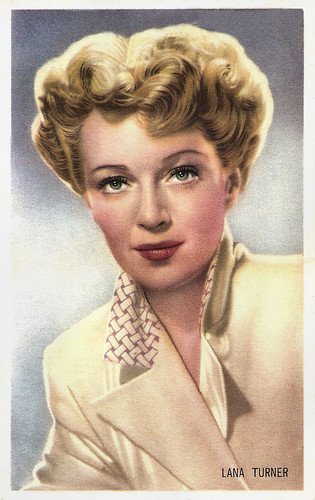
Belgian collectors card by Kwatta, Bois d'Haine, no. C. 209. Photo: Metro-Goldwyn-Mayer.
Lana Turner (1921-1995) was one of the most glamorous superstars of Hollywood's golden era.
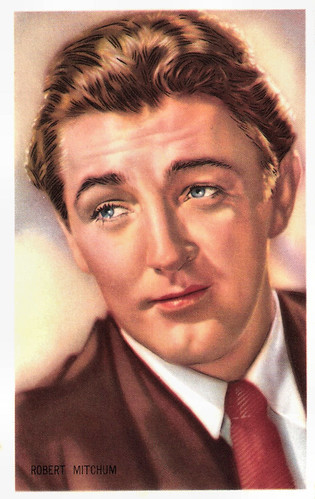
Belgian collectors card by Kwatta, Bois d'Haine, no. C. 215. Photo: M.G.M. Robert Mitchum in Desire Me (George Cukor, Jack Conway, 1947).
American film star Robert Mitchum (1917–1997) is one of the icons of Hollywood thanks to his roles as tough guys, loners and drifters in many War films, Westerns and such classic Film Noirs as Out of the Past (1947) and His Kind of Woman (1952). His facade of cool, sleepy-eyed indifference proved highly attractive to both men and women. Mitchum portrayed two of the scariest screen villains ever: the psychotic evangelist Reverend Harry Powell in Night of the Hunter (1955) and cruel rapist Max Cady in the original Cape Fear (1962). During his notable 55-year acting career, he appeared in more than 125 films.
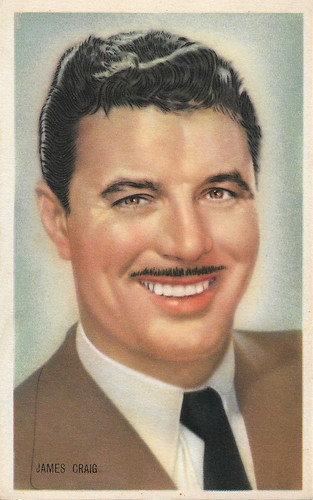
Belgian collectors card by Kwatta, no. C. 221. Photo: MGM.
Tall, rugged American actor James Craig (1912-1985) is best known for appearances in films like Kitty Foyle (1940) and All That Money Can Buy (1941), and his stint as a leading man at Metro-Goldwyn-Mayer in the 1940s where he appeared in films like The Human Comedy (1943).
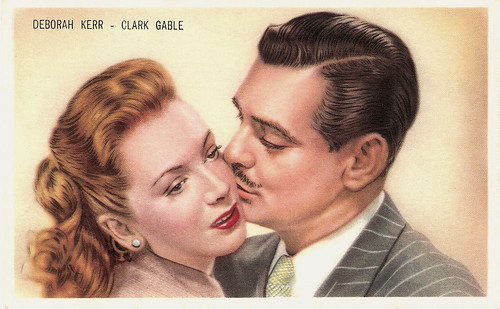
Belgian collectors card by Kwatta, Bois-d'Haine, no. C. 223. Photo: MGM. Deborah Kerr and Clark Gable in The Hucksters (Jack Conway, 1947).
British film star Deborah Kerr (1921-2007) was nicknamed 'The English Rose' for her fresh natural beauty. In many films the stage, television and film actress played 'classic' English ladies, but during the 1950s she became known for her versatile roles in major Hollywood productions.
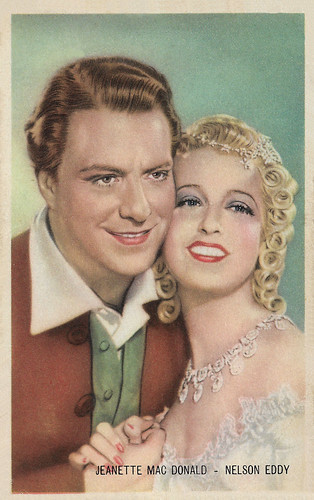
Belgian collectors card by Kwatta, no. C. 224. Photo: MGM. Jeanette MacDonald and Nelson Eddy in New Moon (Robert Z. Leonard, 1940).
Red-headed and blue-green eyed operatic singer Jeanette MacDonald (1903-1965) was discovered for the cinema by Ernst Lubitsch , who cast her opposite Maurice Chevalier in The Love Parade (1929). Later 'the Iron Butterfly' co-starred with Nelson Eddy in a string of successful musicals and played opposite Clark Gable in San Francisco (1936).
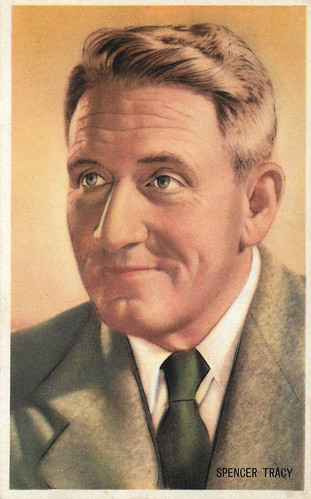
Belgian collectors card by Kwatta, no. C. 232. Photo: MGM. Spencer Tracy in Father of the Bride (Vincente Minnelli, 1950).
American actor Spencer Tracy (1900-1967) was one of the major stars of Hollywood's Golden Age. He was the first actor to win back-to-back Oscars for Captains Courageous (1937) with Freddie Bartholomew, and for playing Father Edward Flanagan in Boys Town (1938) with Mickey Rooney . Considered by his peers as one of the best Hollywood actors, Tracy was noted for his natural performing style and versatility.
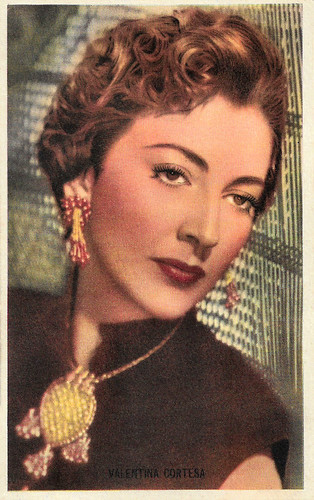
Belgian collectors card by Kwatta, no. C. 243. Photo: MGM. Valentina Cortese in Malaya (Richard Thorpe, 1949).
Italian film and stage actress Valentina Cortese (1923-2019) appeared in more than 100 Italian, French, British and American films and TV series. Cortese was nominated for the Oscar for Best Supporting Actress for her role in François Truffaut’s La nuit américaine/Day for Night (1973). She also worked with such titans of cinema as Michelangelo Antonioni and Federico Fellini.
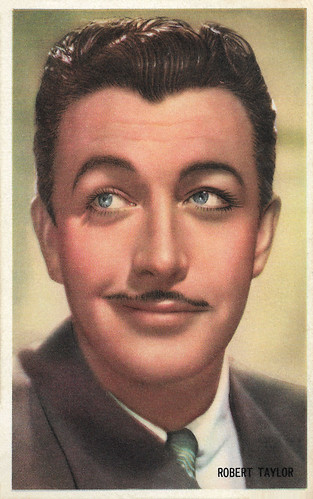
Belgian collectors card by Kwatta, no. C. 248. Photo: MGM. Robert Taylor in Ambush (Sam Wood, 1950).
Robert Taylor (1911-1969) was called "The Man with the Perfect Profile". He won his first leading role in Magnificent Obsession (1935). His popularity increased during the late 1930s and 1940s with appearances in A Yank at Oxford (1938), Waterloo Bridge (1940), and Bataan (1943). He was the quintessential MGM company man until the demise of the studio system in the late 1950s.
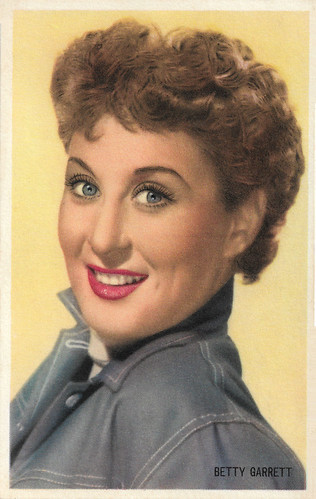
Belgian collectors card by Kwatta, no. C. 253. Photo: MGM. Betty Garrett in On the Town (Stanley Donen, Gene Kelly, 1949).
Betty Garrett (1919-2011) was a sunny American actress, comedian, singer and dancer. She originally performed on Broadway, and was then signed to a film contract with Metro-Goldwyn-Mayer. She appeared successfully in several classic musicals like On the Town (1949) when the Communist scare in the 1950s brought her career to a screeching, ugly halt. She returned to Broadway and made guest appearances on several television series. Garrett later became known for the roles she played in two prominent 1970s sitcoms: Archie Bunker's liberal neighbour Irene Lorenzo in All in the Family (1973-1975) and landlady Edna Babish in Laverne & Shirley (1976-1981).
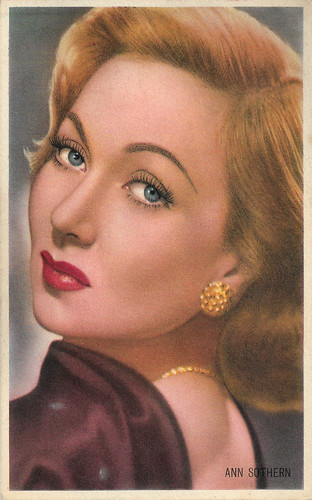
Belgian collectors card by Kwatta, no. C. 283. Photo: MGM. Ann Sothern in Shadow on the Wall (Pat Jackson, 1950).
American actress Ann Sothern (1909-2001) had a career on stage, radio, film, and television, that spanned nearly six decades. In 1939, MGM cast her as Maisie Ravier, a brash yet lovable Brooklyn showgirl, which lead to a successful film series. In 1953, Sothern moved into television as the star of her own sitcom Private Secretary. In 1987, Sothern appeared in her final film The Whales of August, and earned her only Oscar nomination for Best Supporting Actress.
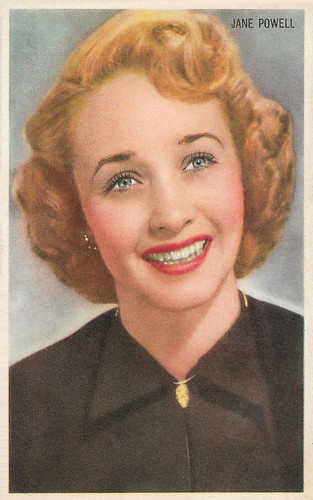
Belgian collectors card by Kwatta, no. C. 288. Photo: MGM. Jane Powell in Nancy Goes to Rio (Robert Z. Leonard, 1950).
Jane Powell (1929) was the singing and dancing star of MGM musicals of the 1940s and 1950s. She is best known for her role as Milly in Seven Brides for Seven Brothers (1954).
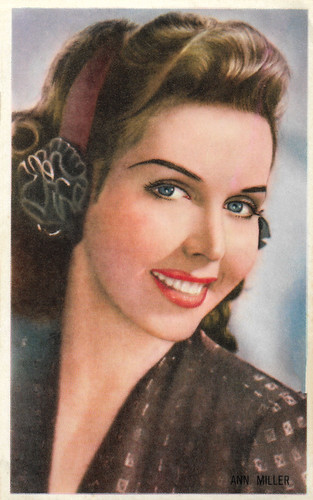
Belgian collectors card by Kwatta, no. C. 306. Photo: MGM. Ann Miller in On the Town (Stanley Donen, Gene Kelly, 1949).
Ann Miller (1923-2004) was an American dancer, singer and actress. She was famed for her speed in tap dancing and her style of glamour: massive black bouffant hair, heavy makeup with a splash of crimson lipstick, and fashions that emphasised her lithe figure and long dancer's legs. Miller is best remembered for her work in the classic Hollywood musicals Easter Parade (1948), On the Town (1949) and Kiss Me Kate (1953).
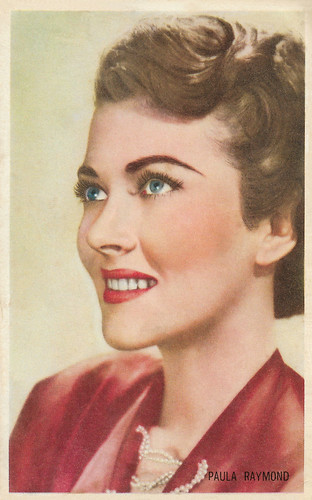
Belgian collectors card by Kwatta, no. C. 315. Photo: MGM. Paula Raymond in Duchess of Idaho (Robert Z. Leonard, 1950).
Paula Raymond (1924-2003) was an American model and actress who played the leading lady in numerous films and television series. In 1950, she was put under contract by MGM, where she played opposite leading men such as Cary Grant and Dick Powell. She is probably best remembered for one of the first atomic monster movies, The Beast From 20,000 Fathoms (1953). In the late 1950s and early 1960s, she appeared in countless episodes of TV series.
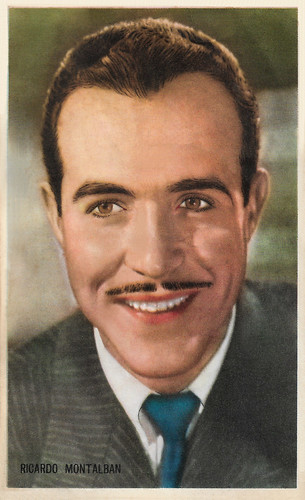
Belgian collectors card by Kwatta, Bois d'Haine, no. C. 317. Photo: Metro-Goldwyn-Mayer.
Handsome Mexican actor Ricardo Montalban (1920-2009) was the epitome of elegance, charm and grace on film, stage and television. In the late 1940s and early 1950s, he reinvigorated the Latin Lover style in Hollywood without achieving top screen stardom. He fought to upscale the Latin image in Hollywood and this may have cost him a number of roles along the way, but he gained respect and a solid reputation and provided wider-range opportunities for Spanish-speaking actors. Montalban is probably best remembered for his starring role as the mysterious Mr. Roarke on the TV series Fantasy Island (1977–1984), with Hervé Villechaize as his partner Tatto, and as Grandfather Valentin in the Spy Kids franchise.
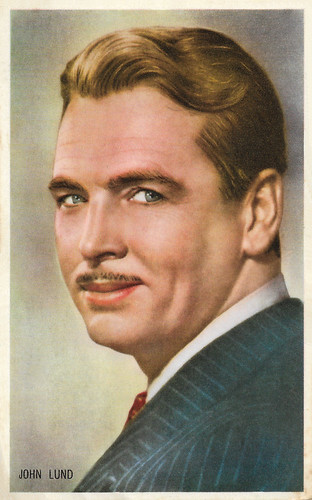
Belgian collectors card by Kwatta, no. C. 321. Photo: MGM. John Lund in Duchess of Idaho (Robert Z. Leonard, 1950).
American actor John Lund (1911-1992) was a handsome blond, blue-eyed leading man who came to Hollywood after a major Broadway success. He started out promisingly in engaging romantic leads in the late 40s, but settled quickly into playing stuffed shirts and the third wheel in love triangles.

Belgian collectors card by Kwatta, Bois d'Haine, no. C. 209. Photo: Metro-Goldwyn-Mayer.
Lana Turner (1921-1995) was one of the most glamorous superstars of Hollywood's golden era.

Belgian collectors card by Kwatta, Bois d'Haine, no. C. 215. Photo: M.G.M. Robert Mitchum in Desire Me (George Cukor, Jack Conway, 1947).
American film star Robert Mitchum (1917–1997) is one of the icons of Hollywood thanks to his roles as tough guys, loners and drifters in many War films, Westerns and such classic Film Noirs as Out of the Past (1947) and His Kind of Woman (1952). His facade of cool, sleepy-eyed indifference proved highly attractive to both men and women. Mitchum portrayed two of the scariest screen villains ever: the psychotic evangelist Reverend Harry Powell in Night of the Hunter (1955) and cruel rapist Max Cady in the original Cape Fear (1962). During his notable 55-year acting career, he appeared in more than 125 films.

Belgian collectors card by Kwatta, no. C. 221. Photo: MGM.
Tall, rugged American actor James Craig (1912-1985) is best known for appearances in films like Kitty Foyle (1940) and All That Money Can Buy (1941), and his stint as a leading man at Metro-Goldwyn-Mayer in the 1940s where he appeared in films like The Human Comedy (1943).

Belgian collectors card by Kwatta, Bois-d'Haine, no. C. 223. Photo: MGM. Deborah Kerr and Clark Gable in The Hucksters (Jack Conway, 1947).
British film star Deborah Kerr (1921-2007) was nicknamed 'The English Rose' for her fresh natural beauty. In many films the stage, television and film actress played 'classic' English ladies, but during the 1950s she became known for her versatile roles in major Hollywood productions.

Belgian collectors card by Kwatta, no. C. 224. Photo: MGM. Jeanette MacDonald and Nelson Eddy in New Moon (Robert Z. Leonard, 1940).
Red-headed and blue-green eyed operatic singer Jeanette MacDonald (1903-1965) was discovered for the cinema by Ernst Lubitsch , who cast her opposite Maurice Chevalier in The Love Parade (1929). Later 'the Iron Butterfly' co-starred with Nelson Eddy in a string of successful musicals and played opposite Clark Gable in San Francisco (1936).

Belgian collectors card by Kwatta, no. C. 232. Photo: MGM. Spencer Tracy in Father of the Bride (Vincente Minnelli, 1950).
American actor Spencer Tracy (1900-1967) was one of the major stars of Hollywood's Golden Age. He was the first actor to win back-to-back Oscars for Captains Courageous (1937) with Freddie Bartholomew, and for playing Father Edward Flanagan in Boys Town (1938) with Mickey Rooney . Considered by his peers as one of the best Hollywood actors, Tracy was noted for his natural performing style and versatility.

Belgian collectors card by Kwatta, no. C. 243. Photo: MGM. Valentina Cortese in Malaya (Richard Thorpe, 1949).
Italian film and stage actress Valentina Cortese (1923-2019) appeared in more than 100 Italian, French, British and American films and TV series. Cortese was nominated for the Oscar for Best Supporting Actress for her role in François Truffaut’s La nuit américaine/Day for Night (1973). She also worked with such titans of cinema as Michelangelo Antonioni and Federico Fellini.

Belgian collectors card by Kwatta, no. C. 248. Photo: MGM. Robert Taylor in Ambush (Sam Wood, 1950).
Robert Taylor (1911-1969) was called "The Man with the Perfect Profile". He won his first leading role in Magnificent Obsession (1935). His popularity increased during the late 1930s and 1940s with appearances in A Yank at Oxford (1938), Waterloo Bridge (1940), and Bataan (1943). He was the quintessential MGM company man until the demise of the studio system in the late 1950s.

Belgian collectors card by Kwatta, no. C. 253. Photo: MGM. Betty Garrett in On the Town (Stanley Donen, Gene Kelly, 1949).
Betty Garrett (1919-2011) was a sunny American actress, comedian, singer and dancer. She originally performed on Broadway, and was then signed to a film contract with Metro-Goldwyn-Mayer. She appeared successfully in several classic musicals like On the Town (1949) when the Communist scare in the 1950s brought her career to a screeching, ugly halt. She returned to Broadway and made guest appearances on several television series. Garrett later became known for the roles she played in two prominent 1970s sitcoms: Archie Bunker's liberal neighbour Irene Lorenzo in All in the Family (1973-1975) and landlady Edna Babish in Laverne & Shirley (1976-1981).

Belgian collectors card by Kwatta, no. C. 283. Photo: MGM. Ann Sothern in Shadow on the Wall (Pat Jackson, 1950).
American actress Ann Sothern (1909-2001) had a career on stage, radio, film, and television, that spanned nearly six decades. In 1939, MGM cast her as Maisie Ravier, a brash yet lovable Brooklyn showgirl, which lead to a successful film series. In 1953, Sothern moved into television as the star of her own sitcom Private Secretary. In 1987, Sothern appeared in her final film The Whales of August, and earned her only Oscar nomination for Best Supporting Actress.

Belgian collectors card by Kwatta, no. C. 288. Photo: MGM. Jane Powell in Nancy Goes to Rio (Robert Z. Leonard, 1950).
Jane Powell (1929) was the singing and dancing star of MGM musicals of the 1940s and 1950s. She is best known for her role as Milly in Seven Brides for Seven Brothers (1954).

Belgian collectors card by Kwatta, no. C. 306. Photo: MGM. Ann Miller in On the Town (Stanley Donen, Gene Kelly, 1949).
Ann Miller (1923-2004) was an American dancer, singer and actress. She was famed for her speed in tap dancing and her style of glamour: massive black bouffant hair, heavy makeup with a splash of crimson lipstick, and fashions that emphasised her lithe figure and long dancer's legs. Miller is best remembered for her work in the classic Hollywood musicals Easter Parade (1948), On the Town (1949) and Kiss Me Kate (1953).

Belgian collectors card by Kwatta, no. C. 315. Photo: MGM. Paula Raymond in Duchess of Idaho (Robert Z. Leonard, 1950).
Paula Raymond (1924-2003) was an American model and actress who played the leading lady in numerous films and television series. In 1950, she was put under contract by MGM, where she played opposite leading men such as Cary Grant and Dick Powell. She is probably best remembered for one of the first atomic monster movies, The Beast From 20,000 Fathoms (1953). In the late 1950s and early 1960s, she appeared in countless episodes of TV series.

Belgian collectors card by Kwatta, Bois d'Haine, no. C. 317. Photo: Metro-Goldwyn-Mayer.
Handsome Mexican actor Ricardo Montalban (1920-2009) was the epitome of elegance, charm and grace on film, stage and television. In the late 1940s and early 1950s, he reinvigorated the Latin Lover style in Hollywood without achieving top screen stardom. He fought to upscale the Latin image in Hollywood and this may have cost him a number of roles along the way, but he gained respect and a solid reputation and provided wider-range opportunities for Spanish-speaking actors. Montalban is probably best remembered for his starring role as the mysterious Mr. Roarke on the TV series Fantasy Island (1977–1984), with Hervé Villechaize as his partner Tatto, and as Grandfather Valentin in the Spy Kids franchise.

Belgian collectors card by Kwatta, no. C. 321. Photo: MGM. John Lund in Duchess of Idaho (Robert Z. Leonard, 1950).
American actor John Lund (1911-1992) was a handsome blond, blue-eyed leading man who came to Hollywood after a major Broadway success. He started out promisingly in engaging romantic leads in the late 40s, but settled quickly into playing stuffed shirts and the third wheel in love triangles.
Published on January 03, 2020 22:00
January 2, 2020
The AristoCats (1970)
The AristoCats (Wolfgang Reitherman, 1970) was the 20th animated feature film produced by Walt Disney Productions. The film is based on a story by Tom McGowan and Tom Rowe, and revolves around a Parisian family of aristocratic cats.

Italian postcard by Grafiche Biondetti, Verona. Illustration: Walt Disney Productions. Publicity still for The AristoCats (Wolfgang Reitherman, 1970).
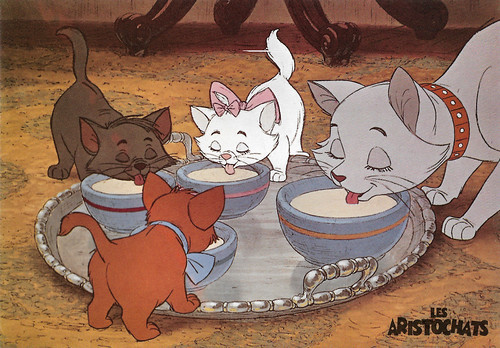
French postcard by MD, no. D 870-1. Illustration: Walt Disney Productions. Publicity still for The AristoCats (Wolfgang Reitherman, 1970).
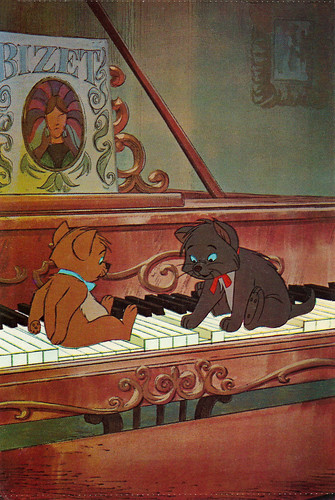
French postcard. Illustration: Walt Disney Productions. Publicity still for The AristoCats (Wolfgang Reitherman, 1970).
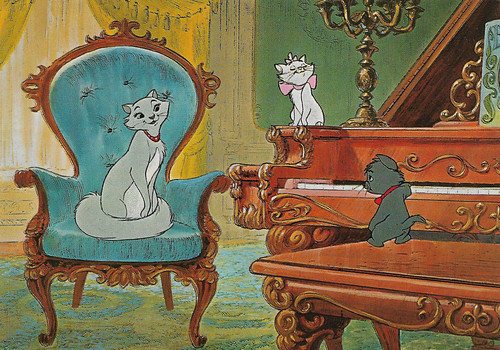
Italian postcard by Grafiche Biondetti, no. 117/4. Illustration: Walt Disney Productions. Publicity still for The AristoCats (Wolfgang Reitherman, 1970).
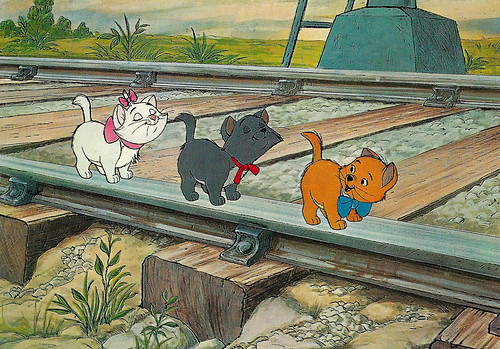
Italian postcard by Grafiche Biondetti, Verona, no. 117. Illustration: Walt Disney Productions. Publicity still for The AristoCats (Wolfgang Reitherman, 1970).
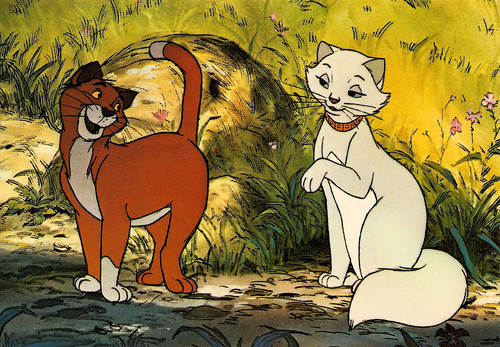
French postcard by Editions Kroma. Illustration: Walt Disney Productions. Publicity still for The AristoCats (Wolfgang Reitherman, 1970).
Pianist Berlioz, painter Toulouse and sanctimonious Marie
The AristoCats (Wolfgang Reitherman, 1970) is set in Paris 1910. Mother cat Duchess and her three kittens, Berlioz, Marie and Toulouse live with retired opera diva Madame Adelaide Bonfamille, and her English butler, Edgar.
The kittens are pianist Berlioz, painter Toulouse and sanctimonious Marie. The family is set to inherit a fortune from their owner. While preparing her will with lawyer Georges Hautecourt, madame Adelaide Bonfamille declares her fortune to be left to her cats until their deaths, and thereafter to Edgar.
Edgar hears this through a speaking tube, and plots to eliminate the cats. The jealous butler drugs tem by putting sleeping pills in a milk mixture intended for them, and kidnaps the cats. He leaves them in the country, so he can gain his mistress's fortune.
In the morning, Duchess meets an alley cat named Thomas O'Malley, who offers to guide her and the kittens to Paris. , the family of felines tries to make it back home.
Edgar tries to cover his tracks and catch them at return, but more animals turn on him, from the cart horse Frou-Frou to the tame mouse Roquefort and O'Malley's jazz friends.
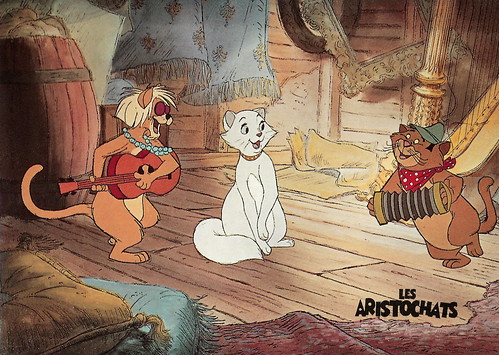
French postcard by MD, Paris, no. D 870-4. Illustration: Walt Disney Productions. Publicity still for The AristoCats (Wolfgang Reitherman, 1970).
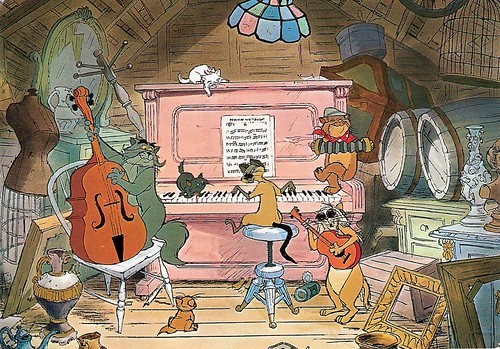
Italian postcard by Grafiche Biondetti, Verona, no. 117/2. Illustration: Walt Disney Productions. Publicity still for The AristoCats (Wolfgang Reitherman, 1970).
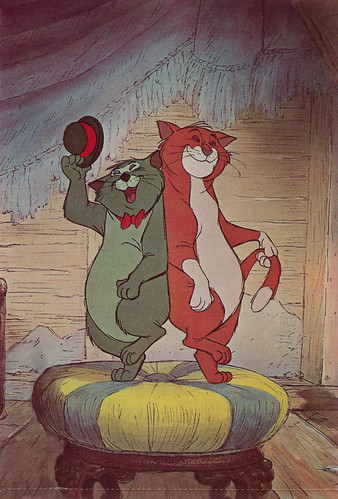
French postcard. Illustration: Walt Disney Productions. Publicity still for The AristoCats (Wolfgang Reitherman, 1970).
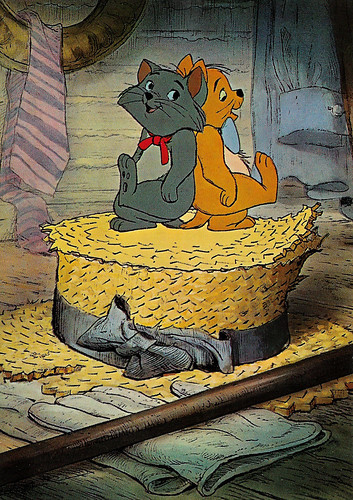
Italian postcard by Grafiche Biondetti, Verona, no. 3119. Illustration: Walt Disney Productions. Publicity still for The AristoCats (Wolfgang Reitherman, 1970).
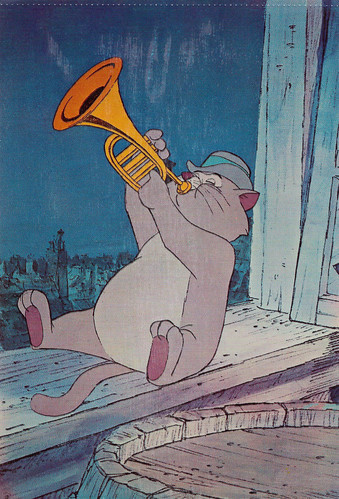
French postcard. Illustration: Walt Disney Productions. Publicity still for The AristoCats (Wolfgang Reitherman, 1970).
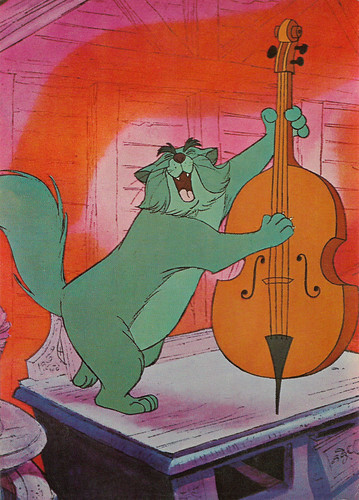
French postcard. Illustration: Walt Disney Productions. Publicity still for The AristoCats (Wolfgang Reitherman, 1970).
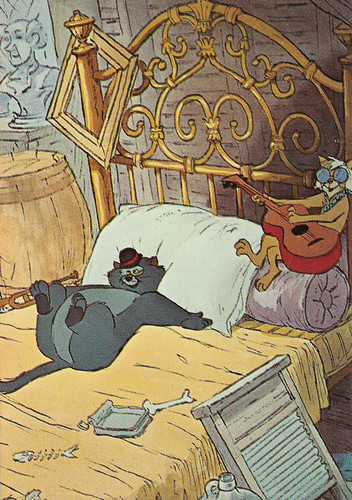
French postcard. Illustration: Walt Disney Productions. Publicity still for The AristoCats (Wolfgang Reitherman, 1970).
Everybody wants to be a cat
In 1962, The AristoCats began as an original script for a two-part live-action episode for Walt Disney's Wonderful World of Color, developed by writers Tom McGowan and Tom Rowe and producer Harry Tytle.
Following two years of re-writes, Walt Disney suggested the project would be more suitable for an animated film, and placed the project in turnaround as The Jungle Book advanced into production.
When The Jungle Book was nearly complete, Disney appointed Ken Anderson to develop preliminary work on The Aristocats, which would mark the last film project to be approved by Disney before his death in December 1966.
The result is charming with great songs like 'Everybody wants to be a cat'. The visual style is deliberately similar to what was used in 101 Dalmatians with the characters having a deliberately sketchy look - an art style used to great effect.
The colour is superb, the humour is constant and the mere fact that the storyline bears a resemblance to the 101 Dalmatians plot does nothing to weaken the film. The AristoCats (Wolfgang Reitherman, 1970) was released in December 1970, to positive reception, and was a box office success.
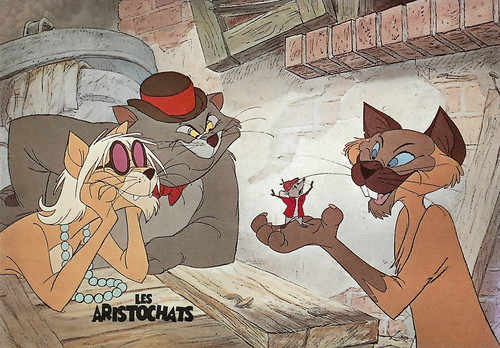
French postcard by MD, Paris, no. D 870-3. Illustration: Walt Disney Productions. Publicity still for The AristoCats (Wolfgang Reitherman, 1970).
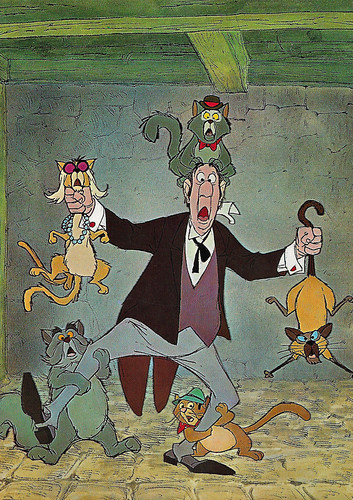
Italian postcard by Grafiche Biondetti, no. 117. Illustration: Walt Disney Productions. Publicity still for The AristoCats (Wolfgang Reitherman, 1970).
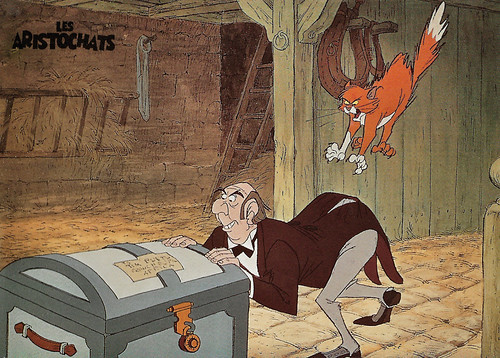
French postcard by MD, Paris, no. D 870-2. Illustration: Walt Disney Productions. Publicity still for The AristoCats (Wolfgang Reitherman, 1970).
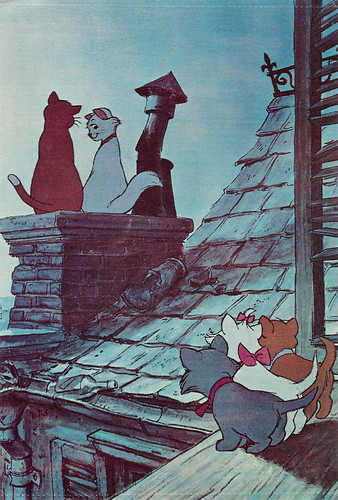
French postcard. Illustration: Walt Disney Productions. Publicity still for The AristoCats (Wolfgang Reitherman, 1970).
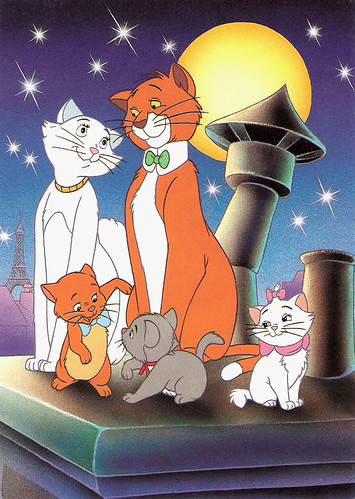
French postcard by Chromovogue, no. D 850 - 3. Illustration: Walt Disney Productions. Publicity still for The AristoCats (Wolfgang Reitherman, 1970).
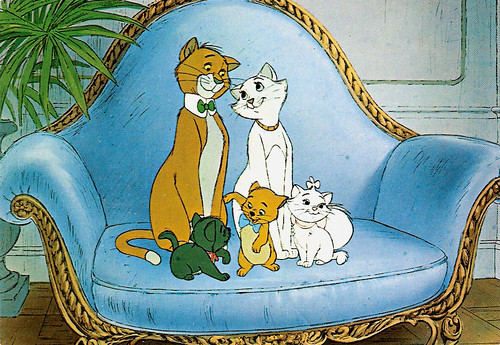
Italian postcard by GTR, no. 3317. Illustration: Walt Disney Productions. Publicity still for The AristoCats (Wolfgang Reitherman, 1970).
Sources: Wikipedia and IMDb.

Italian postcard by Grafiche Biondetti, Verona. Illustration: Walt Disney Productions. Publicity still for The AristoCats (Wolfgang Reitherman, 1970).

French postcard by MD, no. D 870-1. Illustration: Walt Disney Productions. Publicity still for The AristoCats (Wolfgang Reitherman, 1970).

French postcard. Illustration: Walt Disney Productions. Publicity still for The AristoCats (Wolfgang Reitherman, 1970).

Italian postcard by Grafiche Biondetti, no. 117/4. Illustration: Walt Disney Productions. Publicity still for The AristoCats (Wolfgang Reitherman, 1970).

Italian postcard by Grafiche Biondetti, Verona, no. 117. Illustration: Walt Disney Productions. Publicity still for The AristoCats (Wolfgang Reitherman, 1970).

French postcard by Editions Kroma. Illustration: Walt Disney Productions. Publicity still for The AristoCats (Wolfgang Reitherman, 1970).
Pianist Berlioz, painter Toulouse and sanctimonious Marie
The AristoCats (Wolfgang Reitherman, 1970) is set in Paris 1910. Mother cat Duchess and her three kittens, Berlioz, Marie and Toulouse live with retired opera diva Madame Adelaide Bonfamille, and her English butler, Edgar.
The kittens are pianist Berlioz, painter Toulouse and sanctimonious Marie. The family is set to inherit a fortune from their owner. While preparing her will with lawyer Georges Hautecourt, madame Adelaide Bonfamille declares her fortune to be left to her cats until their deaths, and thereafter to Edgar.
Edgar hears this through a speaking tube, and plots to eliminate the cats. The jealous butler drugs tem by putting sleeping pills in a milk mixture intended for them, and kidnaps the cats. He leaves them in the country, so he can gain his mistress's fortune.
In the morning, Duchess meets an alley cat named Thomas O'Malley, who offers to guide her and the kittens to Paris. , the family of felines tries to make it back home.
Edgar tries to cover his tracks and catch them at return, but more animals turn on him, from the cart horse Frou-Frou to the tame mouse Roquefort and O'Malley's jazz friends.

French postcard by MD, Paris, no. D 870-4. Illustration: Walt Disney Productions. Publicity still for The AristoCats (Wolfgang Reitherman, 1970).

Italian postcard by Grafiche Biondetti, Verona, no. 117/2. Illustration: Walt Disney Productions. Publicity still for The AristoCats (Wolfgang Reitherman, 1970).

French postcard. Illustration: Walt Disney Productions. Publicity still for The AristoCats (Wolfgang Reitherman, 1970).

Italian postcard by Grafiche Biondetti, Verona, no. 3119. Illustration: Walt Disney Productions. Publicity still for The AristoCats (Wolfgang Reitherman, 1970).

French postcard. Illustration: Walt Disney Productions. Publicity still for The AristoCats (Wolfgang Reitherman, 1970).

French postcard. Illustration: Walt Disney Productions. Publicity still for The AristoCats (Wolfgang Reitherman, 1970).

French postcard. Illustration: Walt Disney Productions. Publicity still for The AristoCats (Wolfgang Reitherman, 1970).
Everybody wants to be a cat
In 1962, The AristoCats began as an original script for a two-part live-action episode for Walt Disney's Wonderful World of Color, developed by writers Tom McGowan and Tom Rowe and producer Harry Tytle.
Following two years of re-writes, Walt Disney suggested the project would be more suitable for an animated film, and placed the project in turnaround as The Jungle Book advanced into production.
When The Jungle Book was nearly complete, Disney appointed Ken Anderson to develop preliminary work on The Aristocats, which would mark the last film project to be approved by Disney before his death in December 1966.
The result is charming with great songs like 'Everybody wants to be a cat'. The visual style is deliberately similar to what was used in 101 Dalmatians with the characters having a deliberately sketchy look - an art style used to great effect.
The colour is superb, the humour is constant and the mere fact that the storyline bears a resemblance to the 101 Dalmatians plot does nothing to weaken the film. The AristoCats (Wolfgang Reitherman, 1970) was released in December 1970, to positive reception, and was a box office success.

French postcard by MD, Paris, no. D 870-3. Illustration: Walt Disney Productions. Publicity still for The AristoCats (Wolfgang Reitherman, 1970).

Italian postcard by Grafiche Biondetti, no. 117. Illustration: Walt Disney Productions. Publicity still for The AristoCats (Wolfgang Reitherman, 1970).

French postcard by MD, Paris, no. D 870-2. Illustration: Walt Disney Productions. Publicity still for The AristoCats (Wolfgang Reitherman, 1970).

French postcard. Illustration: Walt Disney Productions. Publicity still for The AristoCats (Wolfgang Reitherman, 1970).

French postcard by Chromovogue, no. D 850 - 3. Illustration: Walt Disney Productions. Publicity still for The AristoCats (Wolfgang Reitherman, 1970).

Italian postcard by GTR, no. 3317. Illustration: Walt Disney Productions. Publicity still for The AristoCats (Wolfgang Reitherman, 1970).
Sources: Wikipedia and IMDb.
Published on January 02, 2020 22:00
January 1, 2020
Rose Barsony
Hungarian actress, dancer and singer Rose Barsony (1909-1977) appeared in 16 films from 1929 to 1938, and in one more in 1957. The soubrette was a popular star of the operettas by Paul Abraham. She personified the idealised image of the spirited, happily dancing Hungarian in German and Austrian films, until the Nazis forbade the Jewish star to perform any longer.
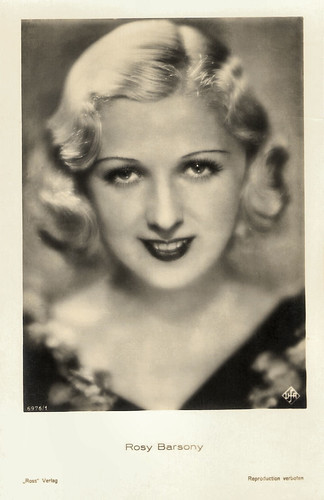
German postcard by Ross Verlag, no. 6976/1, 1931-1932. Photo: Ufa.
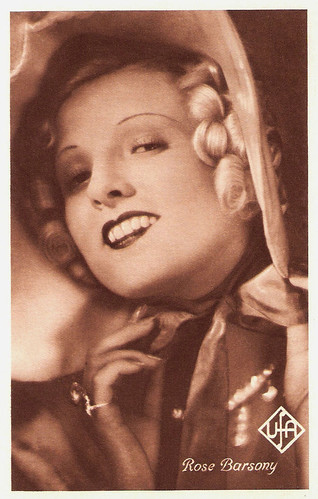
Dutch postcard. Photo: Ufa. Publicity still for Walzerkrieg/The Battle of the Waltzes (Ludwig Berger, 1933).
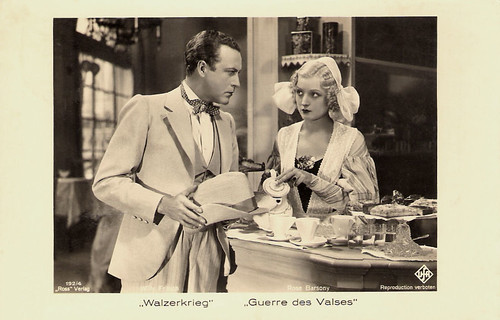
German postcard by Ross Verlag, no. 192/4. Photo: Ufa. Publicity still for Walzerkrieg (Ludwig Berger, 1933) with Rose Barsony and Willy Fritsch .
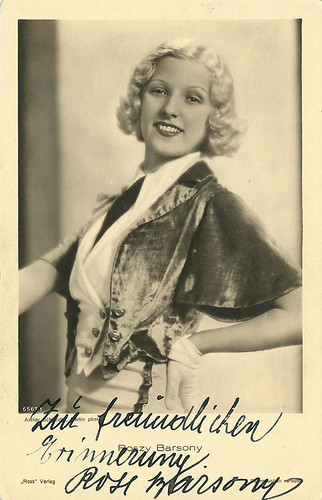
German postcard by Ross Verlag, no. 6567/1, 1931-1932. Photo: Atelier Schneider, Berlin. Collection: Didier Hanson.
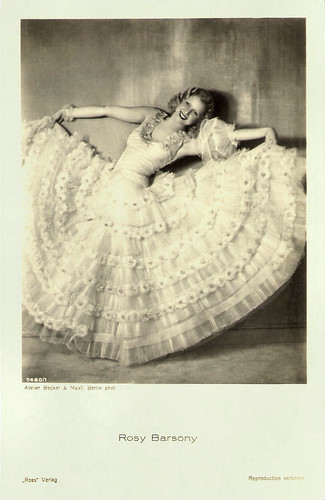
German postcard by Ross Verlag, no. 7480/1, 1932-1933. Photo: Becker & Maass, Berlin.
Soubrette
Rose Barsony - also credited as Rosi Barsony, Rosy Barsony, Rozai Barsony, Rózsi Bársony and Bársony Rózsi - was born as Rose Schustek in Budapest, Hungary in 1909.
She already appeared as a child actress on the stage, but her real career began in 1931 in Berlin with Paul Abraham's operetta 'Viktoria und ihr Husar/Victoria and Her Hussar'. She appeared as a soubrette, a soprano role frequently found in comic operas or operettas; the soubrette usually possesses a flirtatious demeanor and street wise manner.
Another popular operetta by Paul Abraham in which she starred was 'Die Blume von Hawaii/The Flower of Hawaii'.
In 1929 she had made her film debut in her home country with the silent film Mária növér/Sister Mary (Antal Forgács, 1929) starring Werner Pittschau , but especially her German film musicals of the 1930s would enjoy great popularity.
To these films belong Ein toller Einfall/A Mad Idea (Kurt Gerron, 1932), Walzerkrieg/The Battle of the Waltzes (Ludwig Berger, 1933) and the operetta Ball im Savoy/Ball at the Savoy (Steve Sekely, 1935) with Gitta Alpár .
Among her other Hungarian films were A ven gazember/The Old Scoundrel (Heinz Hille, 1932) and the comedy Helyet az öregeknek/Room for the Aged (Béla Gaál, 1934) with Szöke Sakall and Ernö Verebes .
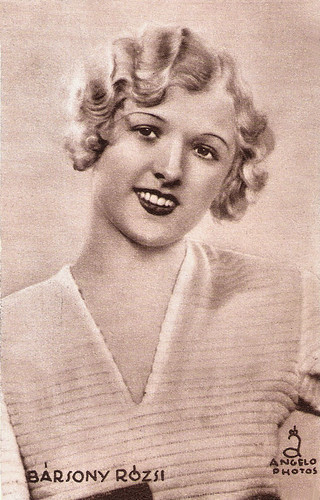
Hungarian postcard by Globus, Budapest. Photo: Angelo Photos.

Small German collectors card in the 'Der künstlerische Tanz' series by Eckstein-Halpaus, Dresden, group 12 (Tanz-Artistik), no. 252. Photo: Alex Binder.
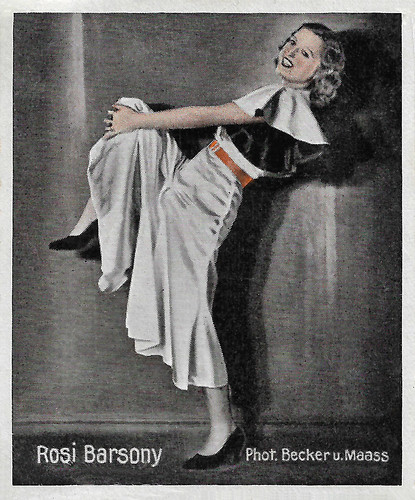
Small German collectors card by Eckstein, Dresden. Photo: Becker und Maass.
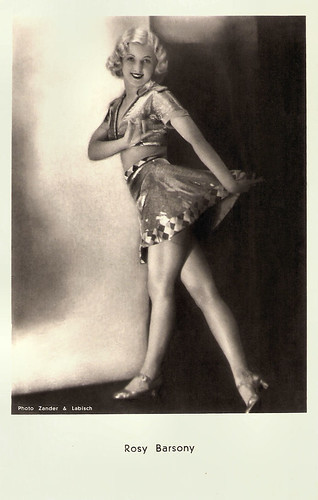
Austrian postcard Iris Verlag, no. 6586. Photo: Zander & Labisch.
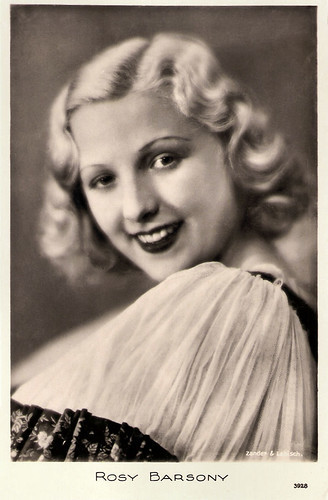
Vintage postcard, no. 3928. Photo: Zander & Labisch.
Fascist Authorities
After the assumption of power of the National Socialists, Rose Barsony got a special approval to work for the Ufa because of her Jewish origin. From 1935 this special arrangement stopped, and Barsony had to leave Germany.
She went on tour with her husband and stage partner, operatta singer Oszkár Dénes. They performed in Romania, Great Britain and the United States. They went to live and work in Italy, but in 1937 the fascist authorities forbade a Milan production of the operetta 'Zizì' with Barsony and her husband because they were Jewish.
During that period she still could appear in the Hungarian films Viki (Márton Keleti, 1937), 3:1 a szerelem javára/3 to 1 for Love (Johann von Vásáry, 1938) - a film adaptation of the Paul Abraham operetta 'Die Entführte Braut/The Kidnapped Bride', and A harapós férj/Biting Husband (Márton Keleti, 1938).
During the war years, Barsony lived in Budapest and because of an Auftrittsverbot she couldn't perform. New Hungarian stars like Marika Rökk followed in her footsteps and now personified the idealised image of the spirited, happily dancing Hungarian in German and Austrian films.
After the war her work was concentrated on the stage, and she worked in Romania and Italy. In 1956 she moved to Vienna to appear in several stage plays and operettas. She only returned on the screen once with Scherben bringen Glück/Seven Years Hard Luck (Ernst Marischka, 1957) starring Adrian Hoven . In 1959 she played at the Stadttheater Klagenfurt, Austria, and later she worked in Paris for French television.
Rose Barsony died in 1977 in Wien (Vienna), Austria. She was 67.
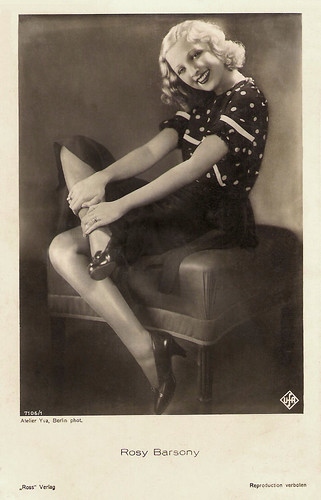
German postcard by Ross Verlag, no. 7106/1, 1932-1933. Photo: Atelier Yva, Berlin / Ufa.
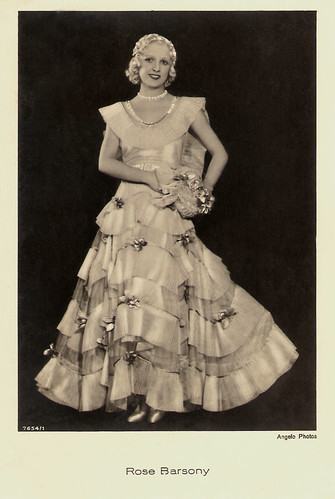
German postcard by Ross Verlag, no. 7654/1, 1932-1933. Photo: Angelo Photos.
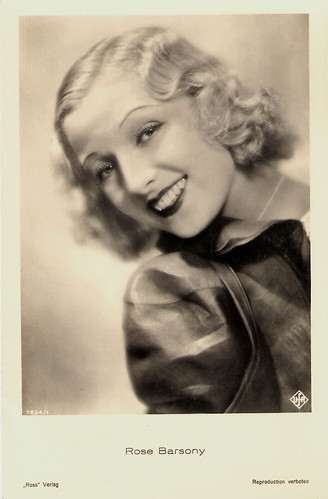
German postcard by Ross Verlag, no. 7834/1, 1932-1933. Photo: Ufa.
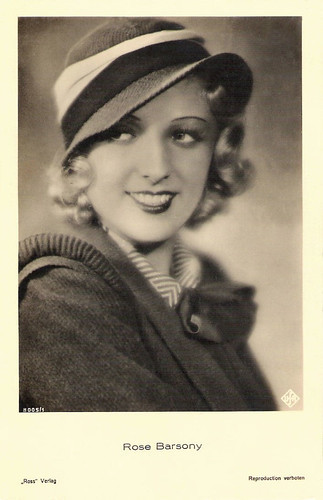
German postcard by Ross Verlag, no. 8005/1, 1933-1934. Photo: Ufa.
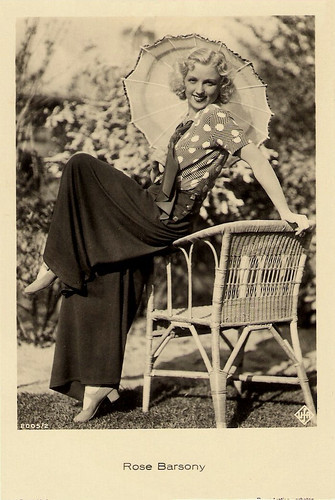
German postcard by Ross Verlag, no. 8005/2, 1933-1934. Photo: Ufa.
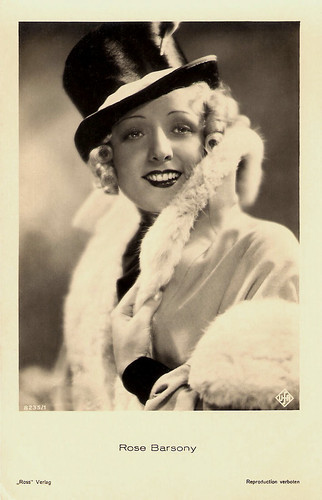
German postcard by Ross Verlag, no. 8235/1, 1933-1934. Photo: Ufa.
Sources: Thomas Staedeli (Cyranos), (IMDb), Allure, Wikipedia (German), and .

German postcard by Ross Verlag, no. 6976/1, 1931-1932. Photo: Ufa.

Dutch postcard. Photo: Ufa. Publicity still for Walzerkrieg/The Battle of the Waltzes (Ludwig Berger, 1933).

German postcard by Ross Verlag, no. 192/4. Photo: Ufa. Publicity still for Walzerkrieg (Ludwig Berger, 1933) with Rose Barsony and Willy Fritsch .

German postcard by Ross Verlag, no. 6567/1, 1931-1932. Photo: Atelier Schneider, Berlin. Collection: Didier Hanson.

German postcard by Ross Verlag, no. 7480/1, 1932-1933. Photo: Becker & Maass, Berlin.
Soubrette
Rose Barsony - also credited as Rosi Barsony, Rosy Barsony, Rozai Barsony, Rózsi Bársony and Bársony Rózsi - was born as Rose Schustek in Budapest, Hungary in 1909.
She already appeared as a child actress on the stage, but her real career began in 1931 in Berlin with Paul Abraham's operetta 'Viktoria und ihr Husar/Victoria and Her Hussar'. She appeared as a soubrette, a soprano role frequently found in comic operas or operettas; the soubrette usually possesses a flirtatious demeanor and street wise manner.
Another popular operetta by Paul Abraham in which she starred was 'Die Blume von Hawaii/The Flower of Hawaii'.
In 1929 she had made her film debut in her home country with the silent film Mária növér/Sister Mary (Antal Forgács, 1929) starring Werner Pittschau , but especially her German film musicals of the 1930s would enjoy great popularity.
To these films belong Ein toller Einfall/A Mad Idea (Kurt Gerron, 1932), Walzerkrieg/The Battle of the Waltzes (Ludwig Berger, 1933) and the operetta Ball im Savoy/Ball at the Savoy (Steve Sekely, 1935) with Gitta Alpár .
Among her other Hungarian films were A ven gazember/The Old Scoundrel (Heinz Hille, 1932) and the comedy Helyet az öregeknek/Room for the Aged (Béla Gaál, 1934) with Szöke Sakall and Ernö Verebes .

Hungarian postcard by Globus, Budapest. Photo: Angelo Photos.

Small German collectors card in the 'Der künstlerische Tanz' series by Eckstein-Halpaus, Dresden, group 12 (Tanz-Artistik), no. 252. Photo: Alex Binder.

Small German collectors card by Eckstein, Dresden. Photo: Becker und Maass.

Austrian postcard Iris Verlag, no. 6586. Photo: Zander & Labisch.

Vintage postcard, no. 3928. Photo: Zander & Labisch.
Fascist Authorities
After the assumption of power of the National Socialists, Rose Barsony got a special approval to work for the Ufa because of her Jewish origin. From 1935 this special arrangement stopped, and Barsony had to leave Germany.
She went on tour with her husband and stage partner, operatta singer Oszkár Dénes. They performed in Romania, Great Britain and the United States. They went to live and work in Italy, but in 1937 the fascist authorities forbade a Milan production of the operetta 'Zizì' with Barsony and her husband because they were Jewish.
During that period she still could appear in the Hungarian films Viki (Márton Keleti, 1937), 3:1 a szerelem javára/3 to 1 for Love (Johann von Vásáry, 1938) - a film adaptation of the Paul Abraham operetta 'Die Entführte Braut/The Kidnapped Bride', and A harapós férj/Biting Husband (Márton Keleti, 1938).
During the war years, Barsony lived in Budapest and because of an Auftrittsverbot she couldn't perform. New Hungarian stars like Marika Rökk followed in her footsteps and now personified the idealised image of the spirited, happily dancing Hungarian in German and Austrian films.
After the war her work was concentrated on the stage, and she worked in Romania and Italy. In 1956 she moved to Vienna to appear in several stage plays and operettas. She only returned on the screen once with Scherben bringen Glück/Seven Years Hard Luck (Ernst Marischka, 1957) starring Adrian Hoven . In 1959 she played at the Stadttheater Klagenfurt, Austria, and later she worked in Paris for French television.
Rose Barsony died in 1977 in Wien (Vienna), Austria. She was 67.

German postcard by Ross Verlag, no. 7106/1, 1932-1933. Photo: Atelier Yva, Berlin / Ufa.

German postcard by Ross Verlag, no. 7654/1, 1932-1933. Photo: Angelo Photos.

German postcard by Ross Verlag, no. 7834/1, 1932-1933. Photo: Ufa.

German postcard by Ross Verlag, no. 8005/1, 1933-1934. Photo: Ufa.

German postcard by Ross Verlag, no. 8005/2, 1933-1934. Photo: Ufa.

German postcard by Ross Verlag, no. 8235/1, 1933-1934. Photo: Ufa.
Sources: Thomas Staedeli (Cyranos), (IMDb), Allure, Wikipedia (German), and .
Published on January 01, 2020 22:00
December 31, 2019
Stars who passed away in 2019
On the first day of 2020, EFSP remembers these stars of the international cinema we had to say farewell to in 2019. Thank you, for your films and for your postcards. Rest in Peace.
21 December 2018: Laya Raki (1927-2018)
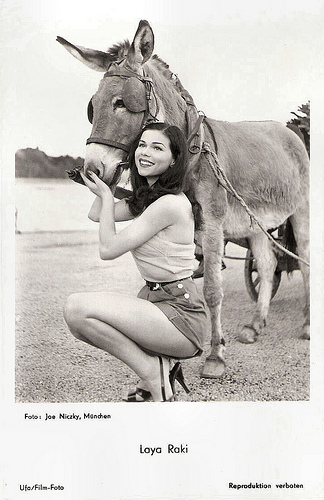
Austrian postcard by HDH-Verlag (Verlag Hubmann), Wien (Vienna). Photo: Joe Niczky, München (Munich) / Ufa.
On 20 January, Marlene Pilaete infomed us that exotic dancer and film actress Laya Raki has passed away on 21 December 2018. During the 1950s, she was a popular sex symbol in Germany. Raki appeared in revealing outfits in films and on photos, and captured men's attention like no other German showgirl. Later, 'the black-haired volcano' also became an international star with her roles in British films and TV productions. Laya Raki was 91.
19 January: Muriel Pavlow (1921-2019)

Big Italian card by Bromofoto, Milano. Photo: Rank. Publicity still for Doctor at Large (Ralph Thomas, 1957).
British actress Muriel Pavlow passed away at the age of 97. The charming, delicate Pavlow was the quintessential English girl of many British films of the 1950s. She was usually cast as an unselfish bride, wife or girlfriend in thrillers and war films. In several light comedies she provided a nice counterbalance to the hectic goings-on. And, despite her small build, she was also a dominant stage actress.
3 February: Julie Adams (1926-2019)
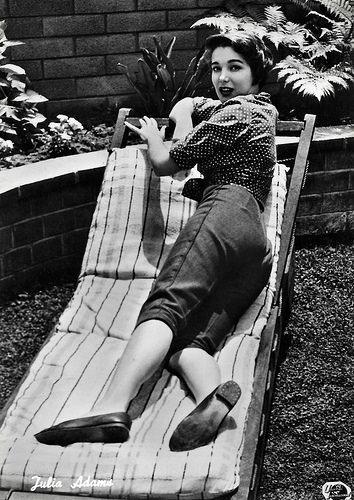
Italian postcard by Bromofoto, Milano, no. 1210. Photo: Universal International.
American actress Julie or Julia Adams passed away on 3 February 2019. Adams starred in a number of films in the 1950s. She was best known for the cult film The Creature of the Black Lagoon (1954).
7 February: Albert Finney (1936–2019)

East-German postcard by VEB Progress Film-Vertrieb, Berlin, no. 1616, 1961. Retail price: 0,20 DM. Photo: Progress. Publicity still for Saturday Night and Sunday Morning (Karel Reisz, 1960).
English actor Albert Finney (1936–2019) was one of the ‘angry young men’ of the Kitchen Sink Theatre and Free Cinema wave. The dynamic, often explosive, stage and screen star was one of the working class and provincial actors that revolutionised British theatre and film in the 1950s and 1960s. Although his early fame was later tempered by long absences from major films, he continued to earn awards and acclaim in a varied five-decade career on stage, films, and television. Albert Finney was 82.
15 February: Bruno Ganz (1941-2019)
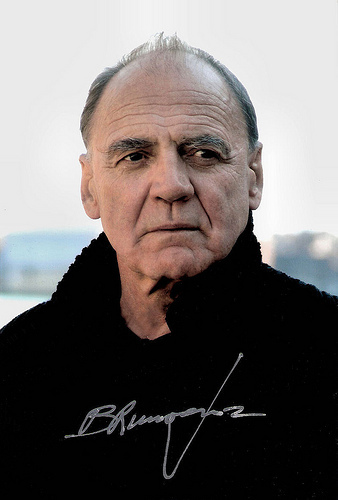
German autograph card.
Swiss actor Bruno Ganz established himself in Germany, first as co-founder of the Schaubuhne Theatre company, then as a romantic lead in films. International renown came Ganz' way when he starred in Eric Rohmer's The Marquise of O (1976). Subsequent film roles ranged from Jonathan Harker in Werner Herzog's Nosferatu/Nosferatu: Phantom of the Night (1979) with Klaus Kinski and Isabelle Adjani, to misplaced angel Damiel in Wim Wenders' Der Himmel über Berlin/Wings of Desire (1987). He also starred in international features by Franklin J. Schaffner, Jonathan Demme and Francis Ford Coppola, and he played Adolf Hitler in the Academy Award-nominated film Der Untergang/Downfall (2004). Bruno Ganz was 77.
20 February: Chelo Alonso (1933-2019)
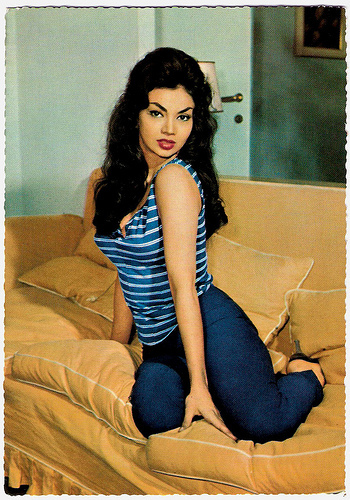
German postcard by Krüger, no. 902/118.
Former Cuban actress, dancer and sex-symbol Chelo Alonso was a star of the Italian cinema of the late 1950s and early 1960s. In several Peplum epics she played femme fatales with fiery tempers and she did sensual dance scenes, mixing Afro-Cuban rhythms with ‘bump and grind’. Ultimately in the DVD era, the ‘Cuban H-bomb’ became a cult heroine for many international B-film buffs. Chelo Alonso was 85.
21 February: Gus Backus (1937-2019)
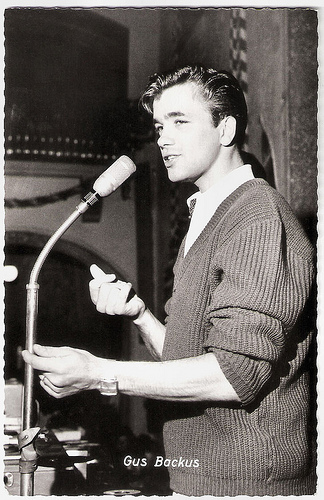
German postcard by Kolibri-Verlag G.m.b.H., Minden/Westf, no. 1560. Photo: Erwin Schneider.
American Singer and actor Gus Backus (1937-2019) was at the age of 19 a member of the Del-Vikings, the first notable Doo-Wop group with both black and white members which had two Billboard Top Ten Hits. Later, he became virtually the flesh-and-blood embodiment of rock 'n roll in Germany. Between 1959 and 1965 he also appeared in 25 German light entertainment films. Gus Backus was 81.
4 March: Luke Perry (1966-2019)

Italian postcard by Gruppo Editoriale Il Vecchio, Genova. Photo: publicity still for the TV-seriesBeverly Hills 90210.
American producer, director, writer, film and TV actor Luke Perry died on 4 March at St. Joseph's Hospital in Burbank, California, from complications of a stroke he suffered a week earlier. Luke had a prolific acting career on TV and in films. He became a household name as Dylan McKay on the hit coming-of-age series Beverly Hills 90210 (1990-1995; 1998-2000). He also starred as Fred Andrews on the drama series Riverdale (2017). He was 52.
7 April: Nadja Regin (1931-2019)
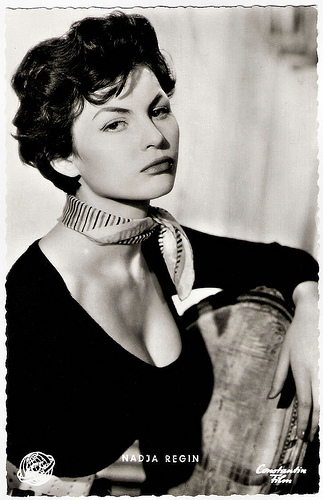
German postcard by Kunst und Bild, Berlin-Charlottenburg, no. I 240. Photo: A. Grimm / CCC / Constantin. Publicity stll for Die Unschuld vom Lande/The Country Wife (Rudolf Schündler, 1957).
Serbian actress Nadja Regin (1931-2019) started her career in Yugoslav-German co-productions and later she worked in Germany, Austria and New Zealand. In England, she guest-starred in many classic TV series of the 1960s and she appeared opposite Sean Connery in two James Bond films. She was 87.
14 April: Bibi Andersson (1935-2019)
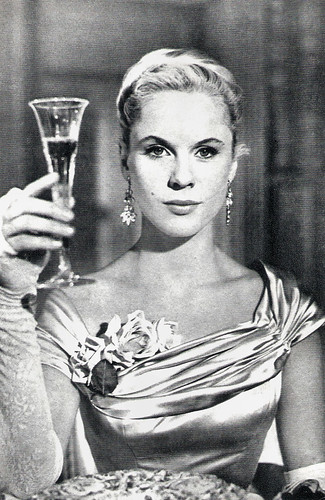
Romanian postcard by Casa Filmului Acin, no. 53. Photo: Bibi Andersson in Smultronstället/Wild Strawberries (Ingmar Bergman, 1957).
Swedish film actress Bibi Andersson died on Sunday 14 April 2019 at the age of 83. She is best known for her 13 films with director Ingmar Bergman.
21 April: Hannelore Elsner (1942-2019)
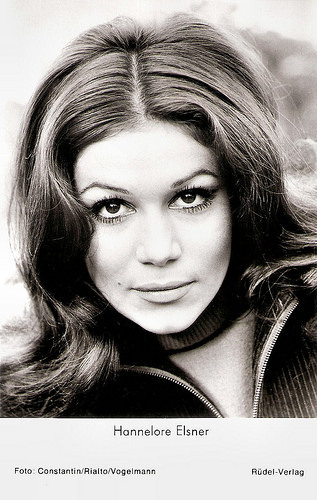
German postcard by Franz Josef Rüdel, Filmpostkartenverlag, Hamburg. Photo: Constantin / Rialto / Vogelmann. Publicity still for Zum Teufel mit der Penne - Die Lümmel von der ersten Bank, 2. Teil/To hell with the pen - The clown of the first bank, Part 2 (Werner Jacobs, 1968).
Grand German actress Hannelore Elsner died from cancer. Elsner started her film career in quickly forgotten light entertainment films, but in later years she starred in films by interesting directors like Edgar Reitz, István Szabó, Dani Levy and Uli Edel. She is best known in Germany for her roles in popular TV series such as Die Schwarzwaldklinik/The Black Forest Hospital (1987-1988) and the Krimi series Die Kommissarin/The Inspectoress (1994-2006).
26 April: Ellen Schwiers (1930-2019)
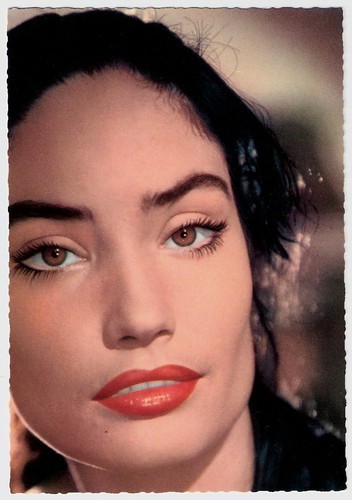
German postcard by ISV, no. M 2. Photo: Europa-Film / List.
German film and stage actress Ellen Schwiers passed away at the age of 88. The versatile actress often appeared as the dark, passionate woman, enmeshed in her own sensuality or another fate. During her 60 year-career she played in ca. 50 films and 150 television productions, but she also worked as a stage actress, director and intendant.
26 April: Elina Bystritskaya (1928-2019)
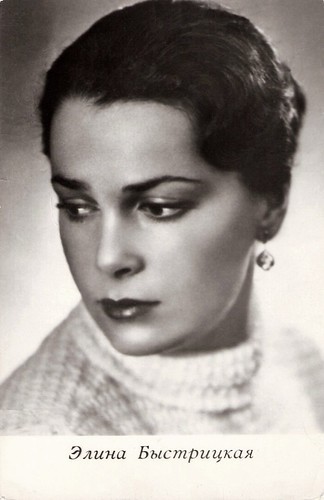
Russian postcard, 1966.
Actress Elina Bystritskaya was one of the most beautiful women of the Soviet cinema. She is best known for her role of Axinia in the epic film trilogy of Mikhail Sholokhov's novel Tikhiy Don/And Quiet Flows the Don (1957-1958) by Sergei Gerasimov. She passed away on 26 April 2019 in Moscow. Bystritskaya was 91.
1 May: Alessandra Panaro (1939-2019)
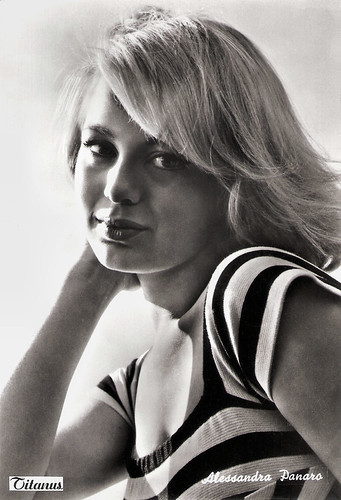
Italian postcard by Bromofoto, Milano, no. 1649. Photo: G.B. Poletto / Titanus. Alessandra Panaro in Cerasella (Raffaello Matarazzo, 1959).
On Wednesday, 1 May 2019, Alessandra Panaro , an Italian former film actress of the late 1950s and early 1960s, passed away. She is best known for Luchino Visconti's crime drama Rocco e i suoi fratelli/Rocco and His Brothers (1960).
13 May: Doris Day (1922-2019)

Dutch postcard by Takken / 't Sticht, no. AX 343. Photo: Warner Bros. Doris Day and Szöke Szakall in Tea for Two (David Butler, 1950), the first film for which Doris Day received top-billing.
Doris Day (1922-2019) died surrounded by her close friends at her California home at the age of 97. The legendary actress and singer with her blonde hair and blue eyes performed with several big bands before going solo in 1947. In the 1950s, she made a series of popular film musicals, including Calamity Jane (1953) and The Pajama Game (1957). 'Que Será, Será!' became her theme song. With Rock Hudson, she starred in the box office hit Pillow Talk (1959). On TV, she appeared in the sitcom The Doris Day Show (1968-1973).
10 July: Valentina Cortese (1923-2019)

Belgian collectors card by Kwatta, no. C. 243. Photo: MGM. Valentina Cortese in Malaya (Richard Thorpe, 1949).
On Wednesday 10 July 2019, Italian film and stage actress Valentina Cortese (1923-2019) passed away in Milan. She appeared in more than 100 Italian, French, British and American films and TV series. Cortese was nominated for the Oscar for Best Supporting Actress for her role in François Truffaut’s La nuit américaine/Day for Night (1973). She also worked with such titans of cinema as Michelangelo Antonioni and Federico Fellini. Valentina Cortese was 96.
19 July: Rutger Hauer (1944-2019)
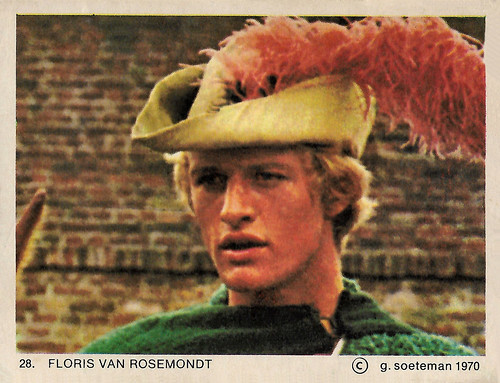
Dutch collectors card, no. 28, 1970. Photo: Gerard Soeteman. Rutger Hauer in the TV series Floris (Paul Verhoeven, 1969).
On Friday, 19 July 2019, Rutger Hauer passed away at his home in Beetsterzwaag, following a short illness. The blonde, blue-eyed, tall and handsome Dutch actor played everything - from romantic leads to action heroes to sinister villains. During the 1970s, he had his international breakthrough with the Dutch films by Paul Verhoeven and later he became a cult star with Blade Runner (1982), The Hitcher (1986) and Blind Fury (1989). Before that he was the hero of many Dutch kids in the classic TV series Floris (1969), also directed by Paul Verhoeven. Hauer was 75.
28 August: Nancy Holloway (1932-2019)
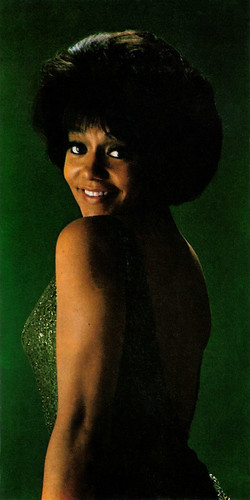
French postcard by Ministar, no. 838. Photo: Patrick de Mervellec.
American singer and actress Nancy Holloway (1932-2019) sang jazz, pop and soul and was popular during the 1960s in France, where she continued to perform and live. She also appeared in a dozen French films. Though born and raised in America, she's virtually unknown in the United States. Nancy Holloway was 86.
3 September: Carol Lynley (1942-2019)
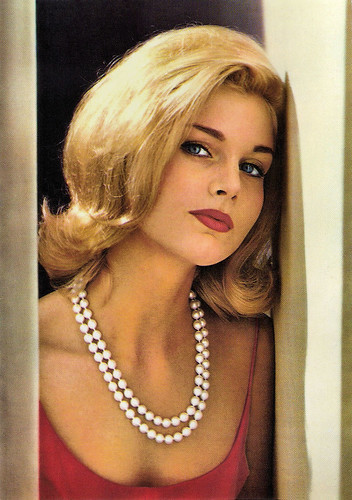
Italian postcard by Rotalfoto, Milano, no. N 159.
Blond, blue-eyed American actress Carol Lynley starred in the The Poseidon Adventure (1972) and numerous other films. She was 77. The actress, who had an attractively feline appeal, earned a Golden Globe nomination as a newcomer for Blue Denim (1959) about a naive teenager seeking an illegal abortion. It was a role she originated on Broadway. On Friday 3 September 2019, Lynley died in her sleep in Los Angeles.
1 October: Karel Gott (1939-2019)
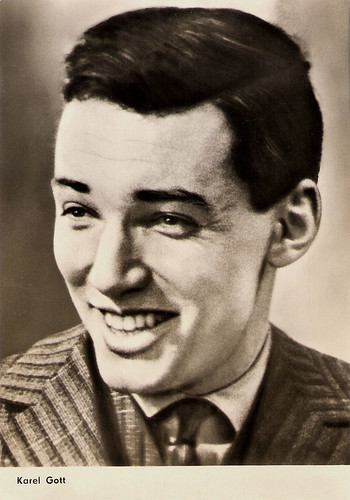
East-German postcard by Progress Starfoto, no. 2376, 1965. Karel Gott in Kdyby tisíc klarinetu/If a Thousand Clarinets (Ján Rohác, Vladimír Svitácek, 1965).
Schlager singer and actor Karel Gott (1939-2019) was the most successful male singer of the Czech Republic, and also had many successes in the German-speaking countries. He released more than 125 albums during his career, selling over 30 million records worldwide. In the annual national poll Český slavík, ‘the Sinatra of the East’ was thirty-eight times elected as the Most Favourite Male Singer.
4 October: Diahann Carroll (1935-2019)
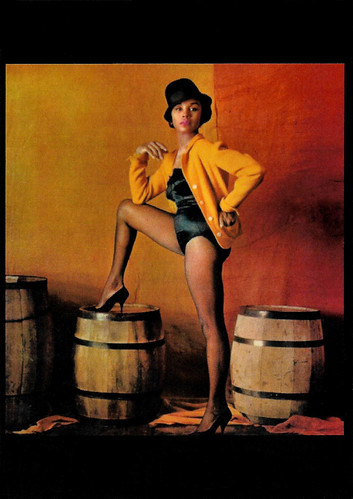
Vintage postcard, no. 018. Photo: Milton H. Greene.
On 4 October 2019, Diahann Carroll died of cancer, aged 84. She was among the foremost African American actors to break down long-seated prejudices in casting. Carroll was the first black performer to have her own sitcom, Julia, which ran for 86 episodes (1968-1971), and the first to win an Emmy in the category of best actress in a leading role in a comedy series. She also won a Tony for her performance in the Broadway musical 'No Strings', written especially for her by Richard Rodgers, which highlighted an interracial romance without mentioning colour. Her films include Carmen Jones (1954), Porgy and Bess (1959), Paris Blues (1961) and Claudine (1974). And her conniving and glamorous Dominique Deveraux was a match for Joan Collins’ Alexis Colby, doubling the 'nasty in Dynasty (1984-1997).
10 October: Marie-José Nat (1940-2019)
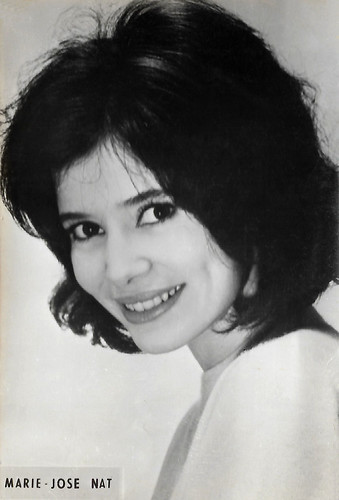
Romanian collectors card.
On 10 October 2019, French actress Marie-José Nat (1940) passed away. She was an acclaimed stage, film and television star, who played glamorous, exotic roles in many films of the 1960s and 1970s. Marie-José Nat was 79.
26 October: Pascale Roberts (1933-2019)
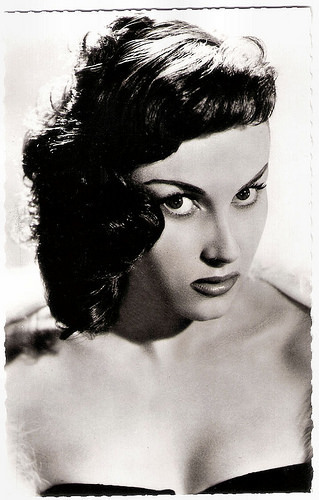
French postcard by Editions P.I., Paris, presented by Les Carbones Korès Carboplane, no. 813. Photo: Sam Lévin.
French actress Pascale Roberts (1933) had been active in the French cinema and television since 1954. From her femme fatale parts in B-thrillers and comedies in the 1950s, she grew into mother roles. She is best known for her parts in A-films by Costa-Gravas, Yves Boisset and Robert Guédiguian, and for her many appearances on French TV.
2 November: Marie Laforêt (1939-2019)
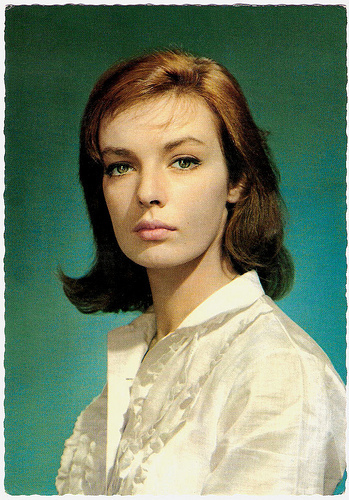
French postcard by E.D.U.G., no. 69.
French singer and actress of Armenian descent Marie Laforêt (1939) passed away at the age of 80. After her first appearance in the drama Plein Soleil (René Clément, 1960) opposite Alain Delon, she became very popular and interpreted many roles in the 1960s. As a singer she is best loved for 'Marie douceur, Marie colère', her version of the Rolling Stones hit 'Paint it black'.
28 November: Stefan Danailov (1942-2019)
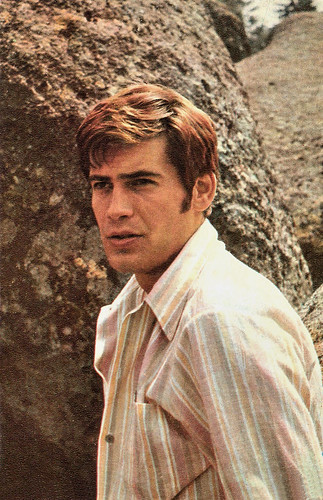
Russian postcard, 1975.
Bulgarian actor Stefan Danailov (1942-2019) starred in over 100 Bulgarian and foreign films, including the Bulgarian classic At each kilometer(1969) and was seen as 'the Bulgarian Alain Delon '. Danailov was part of the ensemble of the National Theatre from 1979 until his death. Apart from his acting work, Danailov was an MP for the Bulgarian Socialist Party (BSP). He was a former Minister of Culture, and was also the BSP Deputy Chairman. 'The legend of Bulgarian cinema' was 76.
14 December: Anna Karina (1940-2019)
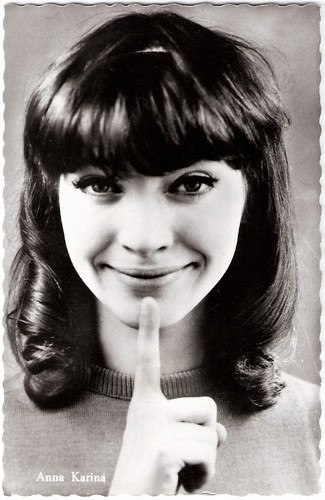
Dutch postcard by Hafbo film, no. 162. Still from Une femme est une femme (Jean-Luc Godard, 1961).
On 14 December, the queen of the Nouvelle Vague, film actress, singer and director Anna Karina passed away. French, but Danish-born Karina was the muse of director Jean-Luc Godard and starred in eight of his films. “Today, French cinema has been orphaned. It has lost one of its legends,” culture minister Franck Riester tweeted. Anna Karina was 79.
18 December: Claudine Auger

Belgian postcard by Edt. Decker, Brussels, no. A. 101. Offered by Korès.
On 18 December 2019, French actress Claudine Auger (1941) passed away. She is best known as Bond girl Domino in the James Bond film Thunderball (1965). At 17, she was Miss France 1958 and she became the first runner-up in the Miss World contest. Later she worked mostly in France and Italy. Claudine Auger was 78.
19 December: Alain Barrière (1935-2019)
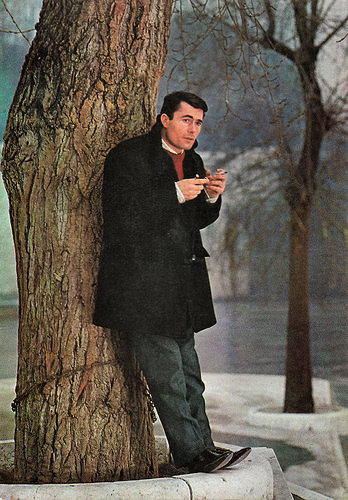
Italian postcard.
French singer and songwriter Alain Barrière passed away on 19 December 2019. He recorded a number of timeless hits in the 1960s which earned their place in French music history. Internationally he is known for participating in the 1963 Eurovision Song Contest. At the height of his popularity, he made one venture into film acting.
21 December 2018: Laya Raki (1927-2018)

Austrian postcard by HDH-Verlag (Verlag Hubmann), Wien (Vienna). Photo: Joe Niczky, München (Munich) / Ufa.
On 20 January, Marlene Pilaete infomed us that exotic dancer and film actress Laya Raki has passed away on 21 December 2018. During the 1950s, she was a popular sex symbol in Germany. Raki appeared in revealing outfits in films and on photos, and captured men's attention like no other German showgirl. Later, 'the black-haired volcano' also became an international star with her roles in British films and TV productions. Laya Raki was 91.
19 January: Muriel Pavlow (1921-2019)

Big Italian card by Bromofoto, Milano. Photo: Rank. Publicity still for Doctor at Large (Ralph Thomas, 1957).
British actress Muriel Pavlow passed away at the age of 97. The charming, delicate Pavlow was the quintessential English girl of many British films of the 1950s. She was usually cast as an unselfish bride, wife or girlfriend in thrillers and war films. In several light comedies she provided a nice counterbalance to the hectic goings-on. And, despite her small build, she was also a dominant stage actress.
3 February: Julie Adams (1926-2019)

Italian postcard by Bromofoto, Milano, no. 1210. Photo: Universal International.
American actress Julie or Julia Adams passed away on 3 February 2019. Adams starred in a number of films in the 1950s. She was best known for the cult film The Creature of the Black Lagoon (1954).
7 February: Albert Finney (1936–2019)

East-German postcard by VEB Progress Film-Vertrieb, Berlin, no. 1616, 1961. Retail price: 0,20 DM. Photo: Progress. Publicity still for Saturday Night and Sunday Morning (Karel Reisz, 1960).
English actor Albert Finney (1936–2019) was one of the ‘angry young men’ of the Kitchen Sink Theatre and Free Cinema wave. The dynamic, often explosive, stage and screen star was one of the working class and provincial actors that revolutionised British theatre and film in the 1950s and 1960s. Although his early fame was later tempered by long absences from major films, he continued to earn awards and acclaim in a varied five-decade career on stage, films, and television. Albert Finney was 82.
15 February: Bruno Ganz (1941-2019)

German autograph card.
Swiss actor Bruno Ganz established himself in Germany, first as co-founder of the Schaubuhne Theatre company, then as a romantic lead in films. International renown came Ganz' way when he starred in Eric Rohmer's The Marquise of O (1976). Subsequent film roles ranged from Jonathan Harker in Werner Herzog's Nosferatu/Nosferatu: Phantom of the Night (1979) with Klaus Kinski and Isabelle Adjani, to misplaced angel Damiel in Wim Wenders' Der Himmel über Berlin/Wings of Desire (1987). He also starred in international features by Franklin J. Schaffner, Jonathan Demme and Francis Ford Coppola, and he played Adolf Hitler in the Academy Award-nominated film Der Untergang/Downfall (2004). Bruno Ganz was 77.
20 February: Chelo Alonso (1933-2019)

German postcard by Krüger, no. 902/118.
Former Cuban actress, dancer and sex-symbol Chelo Alonso was a star of the Italian cinema of the late 1950s and early 1960s. In several Peplum epics she played femme fatales with fiery tempers and she did sensual dance scenes, mixing Afro-Cuban rhythms with ‘bump and grind’. Ultimately in the DVD era, the ‘Cuban H-bomb’ became a cult heroine for many international B-film buffs. Chelo Alonso was 85.
21 February: Gus Backus (1937-2019)

German postcard by Kolibri-Verlag G.m.b.H., Minden/Westf, no. 1560. Photo: Erwin Schneider.
American Singer and actor Gus Backus (1937-2019) was at the age of 19 a member of the Del-Vikings, the first notable Doo-Wop group with both black and white members which had two Billboard Top Ten Hits. Later, he became virtually the flesh-and-blood embodiment of rock 'n roll in Germany. Between 1959 and 1965 he also appeared in 25 German light entertainment films. Gus Backus was 81.
4 March: Luke Perry (1966-2019)

Italian postcard by Gruppo Editoriale Il Vecchio, Genova. Photo: publicity still for the TV-seriesBeverly Hills 90210.
American producer, director, writer, film and TV actor Luke Perry died on 4 March at St. Joseph's Hospital in Burbank, California, from complications of a stroke he suffered a week earlier. Luke had a prolific acting career on TV and in films. He became a household name as Dylan McKay on the hit coming-of-age series Beverly Hills 90210 (1990-1995; 1998-2000). He also starred as Fred Andrews on the drama series Riverdale (2017). He was 52.
7 April: Nadja Regin (1931-2019)

German postcard by Kunst und Bild, Berlin-Charlottenburg, no. I 240. Photo: A. Grimm / CCC / Constantin. Publicity stll for Die Unschuld vom Lande/The Country Wife (Rudolf Schündler, 1957).
Serbian actress Nadja Regin (1931-2019) started her career in Yugoslav-German co-productions and later she worked in Germany, Austria and New Zealand. In England, she guest-starred in many classic TV series of the 1960s and she appeared opposite Sean Connery in two James Bond films. She was 87.
14 April: Bibi Andersson (1935-2019)

Romanian postcard by Casa Filmului Acin, no. 53. Photo: Bibi Andersson in Smultronstället/Wild Strawberries (Ingmar Bergman, 1957).
Swedish film actress Bibi Andersson died on Sunday 14 April 2019 at the age of 83. She is best known for her 13 films with director Ingmar Bergman.
21 April: Hannelore Elsner (1942-2019)

German postcard by Franz Josef Rüdel, Filmpostkartenverlag, Hamburg. Photo: Constantin / Rialto / Vogelmann. Publicity still for Zum Teufel mit der Penne - Die Lümmel von der ersten Bank, 2. Teil/To hell with the pen - The clown of the first bank, Part 2 (Werner Jacobs, 1968).
Grand German actress Hannelore Elsner died from cancer. Elsner started her film career in quickly forgotten light entertainment films, but in later years she starred in films by interesting directors like Edgar Reitz, István Szabó, Dani Levy and Uli Edel. She is best known in Germany for her roles in popular TV series such as Die Schwarzwaldklinik/The Black Forest Hospital (1987-1988) and the Krimi series Die Kommissarin/The Inspectoress (1994-2006).
26 April: Ellen Schwiers (1930-2019)

German postcard by ISV, no. M 2. Photo: Europa-Film / List.
German film and stage actress Ellen Schwiers passed away at the age of 88. The versatile actress often appeared as the dark, passionate woman, enmeshed in her own sensuality or another fate. During her 60 year-career she played in ca. 50 films and 150 television productions, but she also worked as a stage actress, director and intendant.
26 April: Elina Bystritskaya (1928-2019)

Russian postcard, 1966.
Actress Elina Bystritskaya was one of the most beautiful women of the Soviet cinema. She is best known for her role of Axinia in the epic film trilogy of Mikhail Sholokhov's novel Tikhiy Don/And Quiet Flows the Don (1957-1958) by Sergei Gerasimov. She passed away on 26 April 2019 in Moscow. Bystritskaya was 91.
1 May: Alessandra Panaro (1939-2019)

Italian postcard by Bromofoto, Milano, no. 1649. Photo: G.B. Poletto / Titanus. Alessandra Panaro in Cerasella (Raffaello Matarazzo, 1959).
On Wednesday, 1 May 2019, Alessandra Panaro , an Italian former film actress of the late 1950s and early 1960s, passed away. She is best known for Luchino Visconti's crime drama Rocco e i suoi fratelli/Rocco and His Brothers (1960).
13 May: Doris Day (1922-2019)

Dutch postcard by Takken / 't Sticht, no. AX 343. Photo: Warner Bros. Doris Day and Szöke Szakall in Tea for Two (David Butler, 1950), the first film for which Doris Day received top-billing.
Doris Day (1922-2019) died surrounded by her close friends at her California home at the age of 97. The legendary actress and singer with her blonde hair and blue eyes performed with several big bands before going solo in 1947. In the 1950s, she made a series of popular film musicals, including Calamity Jane (1953) and The Pajama Game (1957). 'Que Será, Será!' became her theme song. With Rock Hudson, she starred in the box office hit Pillow Talk (1959). On TV, she appeared in the sitcom The Doris Day Show (1968-1973).
10 July: Valentina Cortese (1923-2019)

Belgian collectors card by Kwatta, no. C. 243. Photo: MGM. Valentina Cortese in Malaya (Richard Thorpe, 1949).
On Wednesday 10 July 2019, Italian film and stage actress Valentina Cortese (1923-2019) passed away in Milan. She appeared in more than 100 Italian, French, British and American films and TV series. Cortese was nominated for the Oscar for Best Supporting Actress for her role in François Truffaut’s La nuit américaine/Day for Night (1973). She also worked with such titans of cinema as Michelangelo Antonioni and Federico Fellini. Valentina Cortese was 96.
19 July: Rutger Hauer (1944-2019)

Dutch collectors card, no. 28, 1970. Photo: Gerard Soeteman. Rutger Hauer in the TV series Floris (Paul Verhoeven, 1969).
On Friday, 19 July 2019, Rutger Hauer passed away at his home in Beetsterzwaag, following a short illness. The blonde, blue-eyed, tall and handsome Dutch actor played everything - from romantic leads to action heroes to sinister villains. During the 1970s, he had his international breakthrough with the Dutch films by Paul Verhoeven and later he became a cult star with Blade Runner (1982), The Hitcher (1986) and Blind Fury (1989). Before that he was the hero of many Dutch kids in the classic TV series Floris (1969), also directed by Paul Verhoeven. Hauer was 75.
28 August: Nancy Holloway (1932-2019)

French postcard by Ministar, no. 838. Photo: Patrick de Mervellec.
American singer and actress Nancy Holloway (1932-2019) sang jazz, pop and soul and was popular during the 1960s in France, where she continued to perform and live. She also appeared in a dozen French films. Though born and raised in America, she's virtually unknown in the United States. Nancy Holloway was 86.
3 September: Carol Lynley (1942-2019)

Italian postcard by Rotalfoto, Milano, no. N 159.
Blond, blue-eyed American actress Carol Lynley starred in the The Poseidon Adventure (1972) and numerous other films. She was 77. The actress, who had an attractively feline appeal, earned a Golden Globe nomination as a newcomer for Blue Denim (1959) about a naive teenager seeking an illegal abortion. It was a role she originated on Broadway. On Friday 3 September 2019, Lynley died in her sleep in Los Angeles.
1 October: Karel Gott (1939-2019)

East-German postcard by Progress Starfoto, no. 2376, 1965. Karel Gott in Kdyby tisíc klarinetu/If a Thousand Clarinets (Ján Rohác, Vladimír Svitácek, 1965).
Schlager singer and actor Karel Gott (1939-2019) was the most successful male singer of the Czech Republic, and also had many successes in the German-speaking countries. He released more than 125 albums during his career, selling over 30 million records worldwide. In the annual national poll Český slavík, ‘the Sinatra of the East’ was thirty-eight times elected as the Most Favourite Male Singer.
4 October: Diahann Carroll (1935-2019)

Vintage postcard, no. 018. Photo: Milton H. Greene.
On 4 October 2019, Diahann Carroll died of cancer, aged 84. She was among the foremost African American actors to break down long-seated prejudices in casting. Carroll was the first black performer to have her own sitcom, Julia, which ran for 86 episodes (1968-1971), and the first to win an Emmy in the category of best actress in a leading role in a comedy series. She also won a Tony for her performance in the Broadway musical 'No Strings', written especially for her by Richard Rodgers, which highlighted an interracial romance without mentioning colour. Her films include Carmen Jones (1954), Porgy and Bess (1959), Paris Blues (1961) and Claudine (1974). And her conniving and glamorous Dominique Deveraux was a match for Joan Collins’ Alexis Colby, doubling the 'nasty in Dynasty (1984-1997).
10 October: Marie-José Nat (1940-2019)

Romanian collectors card.
On 10 October 2019, French actress Marie-José Nat (1940) passed away. She was an acclaimed stage, film and television star, who played glamorous, exotic roles in many films of the 1960s and 1970s. Marie-José Nat was 79.
26 October: Pascale Roberts (1933-2019)

French postcard by Editions P.I., Paris, presented by Les Carbones Korès Carboplane, no. 813. Photo: Sam Lévin.
French actress Pascale Roberts (1933) had been active in the French cinema and television since 1954. From her femme fatale parts in B-thrillers and comedies in the 1950s, she grew into mother roles. She is best known for her parts in A-films by Costa-Gravas, Yves Boisset and Robert Guédiguian, and for her many appearances on French TV.
2 November: Marie Laforêt (1939-2019)

French postcard by E.D.U.G., no. 69.
French singer and actress of Armenian descent Marie Laforêt (1939) passed away at the age of 80. After her first appearance in the drama Plein Soleil (René Clément, 1960) opposite Alain Delon, she became very popular and interpreted many roles in the 1960s. As a singer she is best loved for 'Marie douceur, Marie colère', her version of the Rolling Stones hit 'Paint it black'.
28 November: Stefan Danailov (1942-2019)

Russian postcard, 1975.
Bulgarian actor Stefan Danailov (1942-2019) starred in over 100 Bulgarian and foreign films, including the Bulgarian classic At each kilometer(1969) and was seen as 'the Bulgarian Alain Delon '. Danailov was part of the ensemble of the National Theatre from 1979 until his death. Apart from his acting work, Danailov was an MP for the Bulgarian Socialist Party (BSP). He was a former Minister of Culture, and was also the BSP Deputy Chairman. 'The legend of Bulgarian cinema' was 76.
14 December: Anna Karina (1940-2019)

Dutch postcard by Hafbo film, no. 162. Still from Une femme est une femme (Jean-Luc Godard, 1961).
On 14 December, the queen of the Nouvelle Vague, film actress, singer and director Anna Karina passed away. French, but Danish-born Karina was the muse of director Jean-Luc Godard and starred in eight of his films. “Today, French cinema has been orphaned. It has lost one of its legends,” culture minister Franck Riester tweeted. Anna Karina was 79.
18 December: Claudine Auger

Belgian postcard by Edt. Decker, Brussels, no. A. 101. Offered by Korès.
On 18 December 2019, French actress Claudine Auger (1941) passed away. She is best known as Bond girl Domino in the James Bond film Thunderball (1965). At 17, she was Miss France 1958 and she became the first runner-up in the Miss World contest. Later she worked mostly in France and Italy. Claudine Auger was 78.
19 December: Alain Barrière (1935-2019)

Italian postcard.
French singer and songwriter Alain Barrière passed away on 19 December 2019. He recorded a number of timeless hits in the 1960s which earned their place in French music history. Internationally he is known for participating in the 1963 Eurovision Song Contest. At the height of his popularity, he made one venture into film acting.
Published on December 31, 2019 22:00
December 30, 2019
Happy New Year!
All the best for 2020! Gelukkig Nieuwjaar!, as we say in Dutch. Thanks for your friendship in 2019. Special thanks to Ivo, Carla, Marlene, Beth, Didier, Daniël and Egbert, for sharing their postcards and thoughts with EFSP. I hope to meet you all here again in 2020!

Linda Cristal. Spanish postcard by Archivo Bermejo, no. C-35. Photo: Universal International.
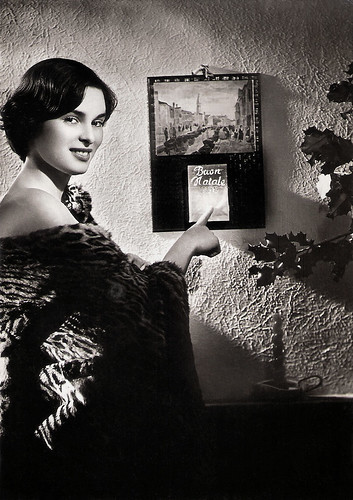
Lucia Bosé . Italian postcard by Italfoto, Terni. Photo: Vedeo. 'Buon natale' on the calendar is Italian for 'Happy new year'. But is the year 1952 or 1958?
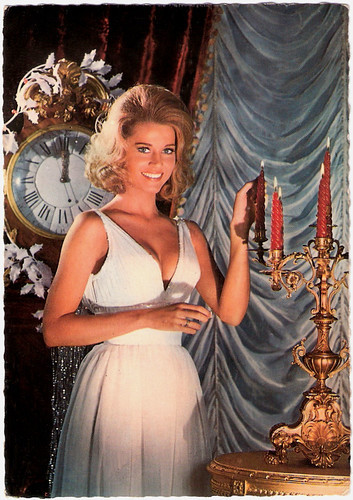
Jane Fonda . French postcard by EDUG, no. 377. Photo: Sam Levin.
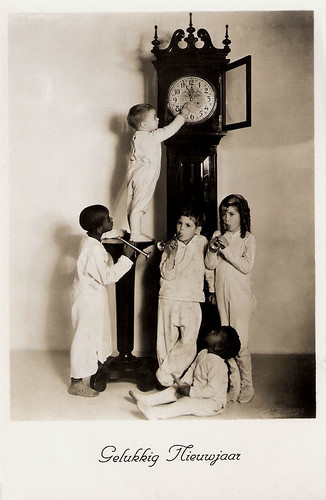
Our Gang. Dutch postcard. Photo: a publicity shot of the Little Rascals a.k.a. Our Gang with Dickie Moore in the middle. Caption: "Gelukkig Nieuwjaar" (Happy New Year).
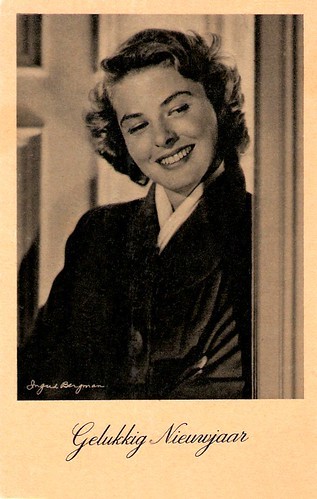
Ingrid Bergman . Dutch postcard. Sent by mail in 1950. Caption: "Gelukkig Nieuwjaar".
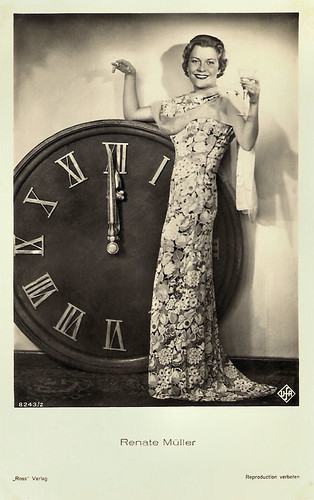
Renate Müller . German postcard by Ross Verlag, no. 8243/2, 1933-1934. Photo: Ufa.
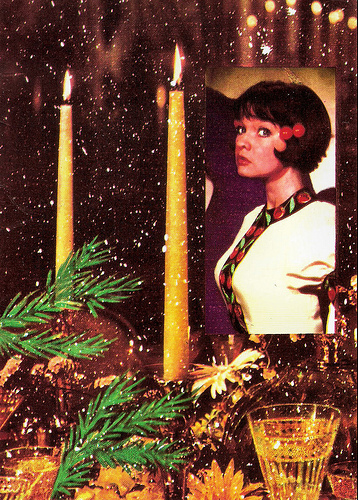
Margareta Pislaru . Romanian postcard by Casa Filmului Acin.
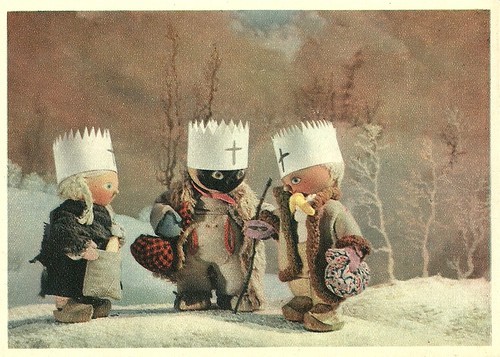
Czech postcard by Orbis, no. D107-7. Photo: publicity still for Špalíček/The Czech Year (Jiri Trnka 1947). Caption: radostne vanoce a mnoho uspechu v novem roce (Merry Christmas and Happy New Year).
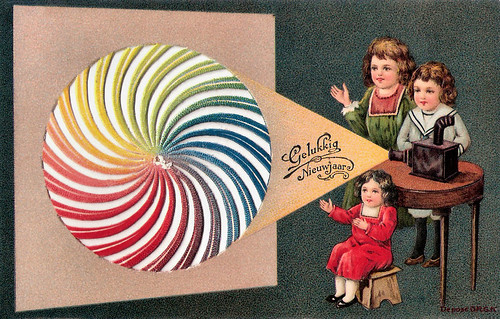
Dutch postcard by L. & B. -B. Sent by mail in 1925.
And finally: we had another record number of visitors: EFSP counted more than 200,000 visits in December 2019! Amazing! Thank you so much for visiting us. Ivo and I appreciate it and your interest motivates us to continue this blog in 2020. So, dank jullie wel and best wishes for 2020!

Linda Cristal. Spanish postcard by Archivo Bermejo, no. C-35. Photo: Universal International.

Lucia Bosé . Italian postcard by Italfoto, Terni. Photo: Vedeo. 'Buon natale' on the calendar is Italian for 'Happy new year'. But is the year 1952 or 1958?

Jane Fonda . French postcard by EDUG, no. 377. Photo: Sam Levin.

Our Gang. Dutch postcard. Photo: a publicity shot of the Little Rascals a.k.a. Our Gang with Dickie Moore in the middle. Caption: "Gelukkig Nieuwjaar" (Happy New Year).

Ingrid Bergman . Dutch postcard. Sent by mail in 1950. Caption: "Gelukkig Nieuwjaar".

Renate Müller . German postcard by Ross Verlag, no. 8243/2, 1933-1934. Photo: Ufa.

Margareta Pislaru . Romanian postcard by Casa Filmului Acin.

Czech postcard by Orbis, no. D107-7. Photo: publicity still for Špalíček/The Czech Year (Jiri Trnka 1947). Caption: radostne vanoce a mnoho uspechu v novem roce (Merry Christmas and Happy New Year).

Dutch postcard by L. & B. -B. Sent by mail in 1925.
And finally: we had another record number of visitors: EFSP counted more than 200,000 visits in December 2019! Amazing! Thank you so much for visiting us. Ivo and I appreciate it and your interest motivates us to continue this blog in 2020. So, dank jullie wel and best wishes for 2020!
Published on December 30, 2019 22:00
December 29, 2019
Jean-Pierre Léaud
French actor Jean-Pierre Léaud (1944) is best known for playing Antoine Doinel in Les Quatre Cents Coups/The 400 Blows (1959) and François Truffaut's following series of films about that character. He also worked several times with Jean-Luc Godard, and is one of the icons of the French New Wave. He is also known for his staccato diction.
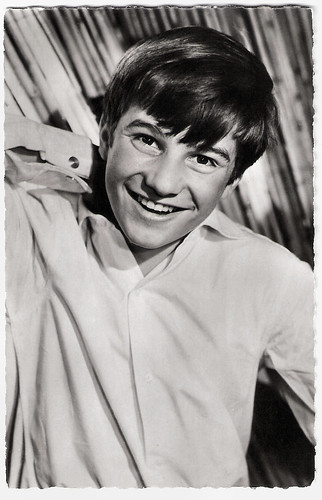
French postcard by Editions du Globe, Paris, no. 870. Photo: Studio Vauclair, Paris.

East-German postcard by VEB Progress Film-Vertrieb, Berlin, no. 208/71, 1971. Photo: Linke.

French postcard by Editions Le Malibran, Paris, no. CF 31. Photo: P. Lhomme. Jean-Pierre Léaud, Françoise Lebrun and Bernadette Lafont in La Maman et la Putain (Jean Eustache, 1973).
Becoming Antoine Doinel
Jean-Pierre Léaud was born in Paris in 1944. He was the son of an assistant scriptwriter, Pierre Léaud, and the actress Jacqueline Pierreux.
Léaud made his major debut as an actor at the age of 14 as Antoine Doinel, a semi-autobiographical character based on the life events of French film director François Truffaut, in his debut film Les Quatre Cents Coups/The 400 Blows (1959). To cast the two adolescents, Truffaut published an announcement in the newspaper France-Soir and auditioned several hundred children in September and October 1958. Jean Domarchi, a critic at the film magazine Cahiers du cinéma, recommended Léaud.
Truffaut was immediately captivated by the fourteen-year-old adolescent, who had already appeared with Jean Marais in the Swashbuckler La Tour, prends garde !/The Tower, watch out! (Georges Lampin, 1958). Jean-Pierre Léaud, then in the eighth grade at a private school in Pontigny, was a far from ideal student. He often ran away with the older students on their nights out, but could also be brilliant, generous, and affectionate.
During and following the filming of Les Quatre Cents Coups/The 400 Blows (1959), Truffaut's concern for Léaud extended beyond the film set. He took charge of the difficult adolescent's upbringing after Léaud was expelled from school and kicked out of the home of the retired couple taking care of him. Truffaut subsequently rented a studio apartment for Léaud. Truffaut also hired him for assistant work on La peau douce/The Soft Skin (François Truffaut, 1964) and Mata Hari, Agent H21 (François Truffaut, 1964).
After the short-film Antoine et Colette (François Truffaut, 1962), a segment of the anthology film L'amour à vingt ansLove at 20 (1962), Léaud starred in four more Truffaut films depicting the life of Doinel, spanning a period of 20 years. Those films are Baisers volés/Stolen Kisses (François Truffaut, 1968), Domicile conjugal/Bed and Board (François Truffaut, 1970) and L'amour en fuite/Love on the Run (François Truffaut, 1979), all with Claude Jade as his girlfriend, wife or ex.
He also collaborated with Truffaut on non-Antoine Doinel films like Les Deux Anglaises et le Continent/Two English Girls (François Truffaut, 1971) and La Nuit américaine/Day for Night (François Truffaut, 1973) and became the actor most commonly affiliated with him. Although Antoine Doinel is his most familiar character, he often found his performances in other films to be compared to his Doinel character whether there were legitimate similarities or not.
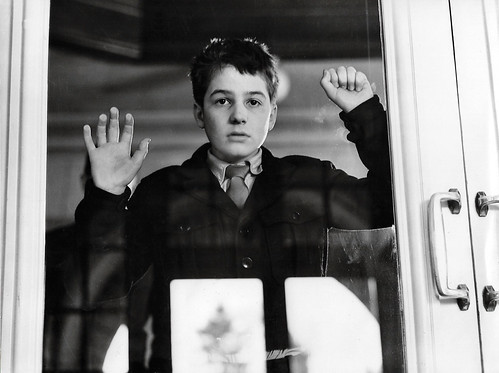
German press photo by Bildarchiv Engelmeier, München. Jean-Pierre Léaud in Les Quatre Cents Coups/The 400 Blows (François Truffaut, 1959).
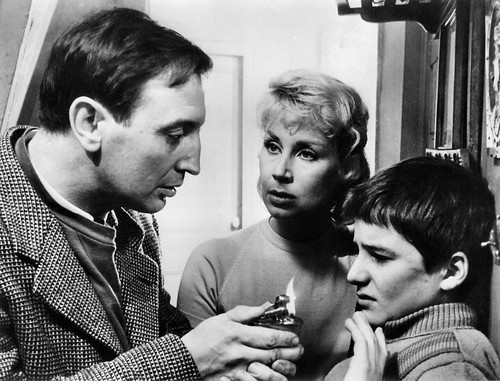
German press photo by Bildarchiv Engelmeier, München. Issued for the broadcasting by the ZDF on 8 January 1998. Jean-Pierre Léaud, Albert Remy and Claire Maurier in Les quatre cents coups/The 400 Blows (François Truffaut, 1959).
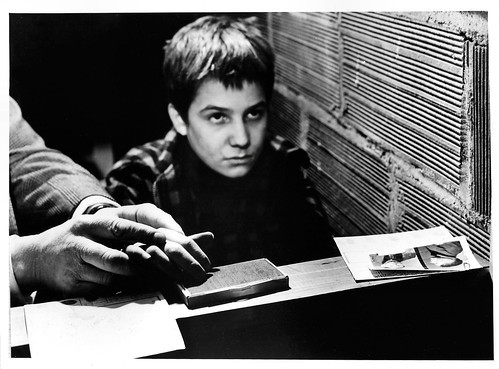
German press photo by Tele Bunk ttv, Berlin. Issued for the broadcasting by the ZDF on 8 January 1998. Jean-Pierre Léaud in Les quatre cents coups/The 400 Blows (François Truffaut, 1959).
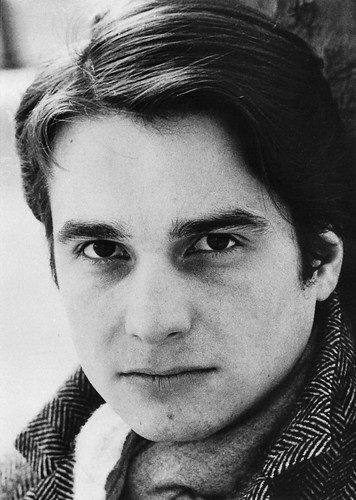
German press photo by Kövesdi Presse Agentur, München (Munich). Used for the German broadcasting by ZDF in 1983. Jean-Pierre Léaud in Antoine et Colette/Antoine and Colette (François Truffaut, 1962).
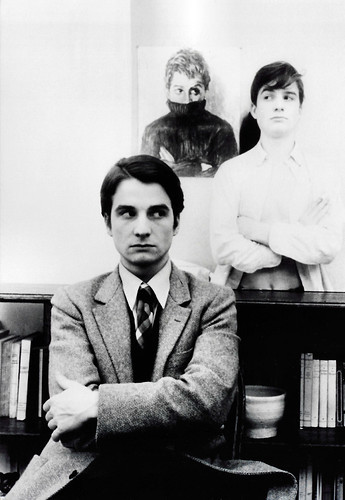
German press photo by ORF. Used for the German broadcasting of the film in 1994. Jean-Pierre Léaud in Baisers volés/Stolen Kisses (François Truffaut, 1968).
An exciting comeback
Jean-Pierre Léaud is one of the most visible and well-known actors to be associated with the Nouvelle Vague, the French New Wave film movement and, aside from his work with Truffaut, he collaborated with Jean-Luc Godard on nine films, Jean Eustache, Jacques Rivette and Agnès Varda.
In 1966, he won the Silver Bear for Best Actor at the Berlin International Film Festival for his role in Masculin Féminin (Jean Luc Godard, 1966). He was in Pier Paolo Pasolini's Porcile/Pigsty (1968), in Jerzy Skolimowski’s Dialog 20-40-60/Dialogue 20-40-60 (1968), Brazilian Carlos Diegues' Os herdeiros/The Heirs (1970) and Glauber Rocha's Der Leone have sept cabeças/The Lion Has Seven Heads (1971).
The early 1970s was perhaps the peak of his professional career when he had three critically acclaimed films released: Bernardo Bertolucci's Ultimo tango a Parigi/Last Tango in Paris (1972), Truffaut's La Nuit américaine/Day for Night (1973), and Jean Eustache's La Maman et la Putain/The Mother and the Whore (1973) with Bernadette Lafont . In the Bertolucci film, Léaud appeared in the same film as a hero of his, Marlon Brando , although the two men never met, since all of Léaud's scenes were shot on Saturdays and Brando refused to work on Saturdays.
In 1988, Léaud was nominated for a César Award for Best Supporting Actor for the comedy Les Keufs/Lady Cops (Josiane Balasko, 1987) and was awarded an Honorary César for lifetime achievement in 2000. He made an exciting comeback in the nineties when several ‘new New Wave’ directors hired Léaud to pay homage to their elders. Among them French film makers such as Olivier Assayas, Danièle Dubroux, Serge Le Péron, Bertrand Bonello and foreigners like Finnish Aki Käurismäki and Taiwanese Tsai Ming-Liang.
In 2016, Léaud received the Honorary Palme d'Or at the 2016 Cannes Film Festival, and in 2017, he won the Lumières Award for Best Actor for his role in the historical drama La Mort de Louis XIV/The Death of Louis XIV (Albert Serra, 2017). Jean-Pierre Léaud is married to the French actress Brigitte Duvivier.

German press photo.

German press photo by ORF. Released for the broadcasting on 1 October 1994. Jean-Pierre Léaud and Claude Jade in Domicile Conjugal (François Truffaut, 1970).
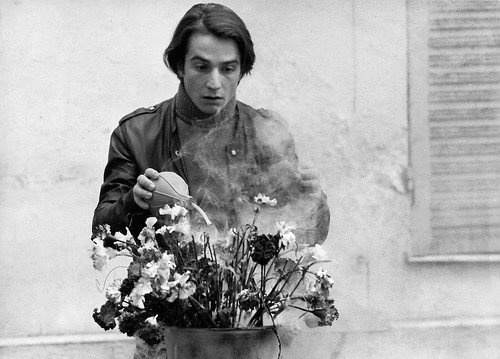
German press photo by Goepfert Arthur, Tessin, Barbengo / Films du Carrosse / Valoria Films, Paris / Fida Cinematografica, Rome. Jean-Pierre Léaud in Domicile Conjugal (François Truffaut, 1970).
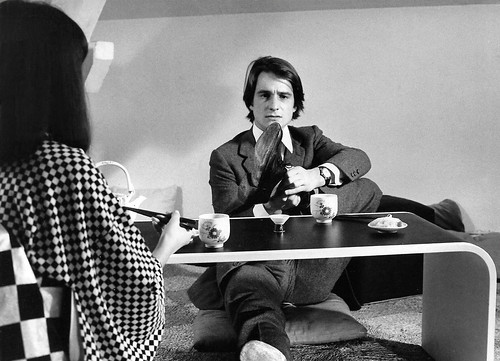
German press photo by Goepfert Arthur, Tessin, Barbengo / Films du Carrosse / Valoria Films, Paris / Fida Cinematografica, Rome. Jean-Pierre Léaud and Hiroko Berghauer in Domicile Conjugal (François Truffaut, 1970).
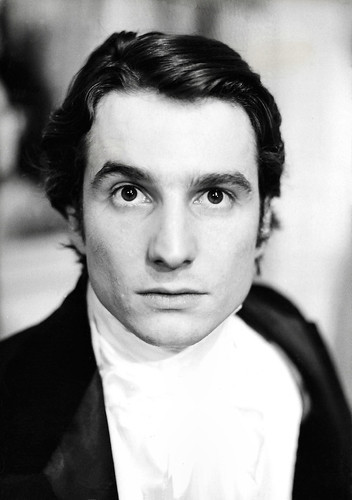
German press photo by K.P.A., Düsseldorf. The photo was used for a broadcasting by NDR/RB/SFB Fernsehen III at 27 and 28 December 1972.
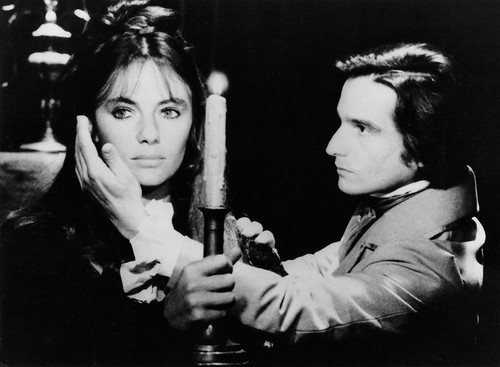
German press photo. Photo: defd / Foto Engelmeier, München. Jacqueline Bisset and Jean-Pierre Léaud in La nuit américaine/Day for Night (François Truffaut, 1973). The press photo was used for the German broadcasting of the film by the ARD on 20 December 1981.

German press photo. Photo: Felicitas Timpe, München. Jean-Pierre Léaud in Umarmungen und andere Sachen/Embraces (Jochen Richter, 1975). Issued for the broadcasting of the film by the ARD on 4 October 1977.

German press photo. Photo: Felicitas Timpe, München. Anny Duperey , Jean-Pierre Léaud and Sydne Rome in Umarmungen und andere Sachen/Embraces (Jochen Richter, 1975).
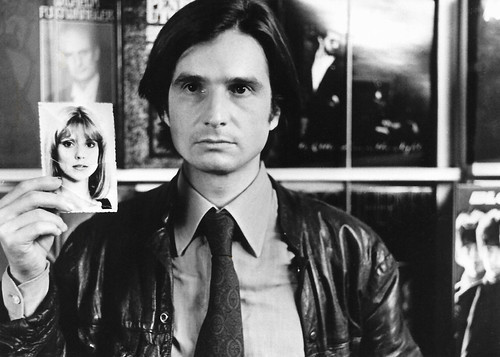
German press photo. Jean-Pierre Léaud in L'amour en fuite/Love on the Run (François Truffaut, 1979).
Sources: (IMDb), Wikipedia and .

French postcard by Editions du Globe, Paris, no. 870. Photo: Studio Vauclair, Paris.

East-German postcard by VEB Progress Film-Vertrieb, Berlin, no. 208/71, 1971. Photo: Linke.

French postcard by Editions Le Malibran, Paris, no. CF 31. Photo: P. Lhomme. Jean-Pierre Léaud, Françoise Lebrun and Bernadette Lafont in La Maman et la Putain (Jean Eustache, 1973).
Becoming Antoine Doinel
Jean-Pierre Léaud was born in Paris in 1944. He was the son of an assistant scriptwriter, Pierre Léaud, and the actress Jacqueline Pierreux.
Léaud made his major debut as an actor at the age of 14 as Antoine Doinel, a semi-autobiographical character based on the life events of French film director François Truffaut, in his debut film Les Quatre Cents Coups/The 400 Blows (1959). To cast the two adolescents, Truffaut published an announcement in the newspaper France-Soir and auditioned several hundred children in September and October 1958. Jean Domarchi, a critic at the film magazine Cahiers du cinéma, recommended Léaud.
Truffaut was immediately captivated by the fourteen-year-old adolescent, who had already appeared with Jean Marais in the Swashbuckler La Tour, prends garde !/The Tower, watch out! (Georges Lampin, 1958). Jean-Pierre Léaud, then in the eighth grade at a private school in Pontigny, was a far from ideal student. He often ran away with the older students on their nights out, but could also be brilliant, generous, and affectionate.
During and following the filming of Les Quatre Cents Coups/The 400 Blows (1959), Truffaut's concern for Léaud extended beyond the film set. He took charge of the difficult adolescent's upbringing after Léaud was expelled from school and kicked out of the home of the retired couple taking care of him. Truffaut subsequently rented a studio apartment for Léaud. Truffaut also hired him for assistant work on La peau douce/The Soft Skin (François Truffaut, 1964) and Mata Hari, Agent H21 (François Truffaut, 1964).
After the short-film Antoine et Colette (François Truffaut, 1962), a segment of the anthology film L'amour à vingt ansLove at 20 (1962), Léaud starred in four more Truffaut films depicting the life of Doinel, spanning a period of 20 years. Those films are Baisers volés/Stolen Kisses (François Truffaut, 1968), Domicile conjugal/Bed and Board (François Truffaut, 1970) and L'amour en fuite/Love on the Run (François Truffaut, 1979), all with Claude Jade as his girlfriend, wife or ex.
He also collaborated with Truffaut on non-Antoine Doinel films like Les Deux Anglaises et le Continent/Two English Girls (François Truffaut, 1971) and La Nuit américaine/Day for Night (François Truffaut, 1973) and became the actor most commonly affiliated with him. Although Antoine Doinel is his most familiar character, he often found his performances in other films to be compared to his Doinel character whether there were legitimate similarities or not.

German press photo by Bildarchiv Engelmeier, München. Jean-Pierre Léaud in Les Quatre Cents Coups/The 400 Blows (François Truffaut, 1959).

German press photo by Bildarchiv Engelmeier, München. Issued for the broadcasting by the ZDF on 8 January 1998. Jean-Pierre Léaud, Albert Remy and Claire Maurier in Les quatre cents coups/The 400 Blows (François Truffaut, 1959).

German press photo by Tele Bunk ttv, Berlin. Issued for the broadcasting by the ZDF on 8 January 1998. Jean-Pierre Léaud in Les quatre cents coups/The 400 Blows (François Truffaut, 1959).

German press photo by Kövesdi Presse Agentur, München (Munich). Used for the German broadcasting by ZDF in 1983. Jean-Pierre Léaud in Antoine et Colette/Antoine and Colette (François Truffaut, 1962).

German press photo by ORF. Used for the German broadcasting of the film in 1994. Jean-Pierre Léaud in Baisers volés/Stolen Kisses (François Truffaut, 1968).
An exciting comeback
Jean-Pierre Léaud is one of the most visible and well-known actors to be associated with the Nouvelle Vague, the French New Wave film movement and, aside from his work with Truffaut, he collaborated with Jean-Luc Godard on nine films, Jean Eustache, Jacques Rivette and Agnès Varda.
In 1966, he won the Silver Bear for Best Actor at the Berlin International Film Festival for his role in Masculin Féminin (Jean Luc Godard, 1966). He was in Pier Paolo Pasolini's Porcile/Pigsty (1968), in Jerzy Skolimowski’s Dialog 20-40-60/Dialogue 20-40-60 (1968), Brazilian Carlos Diegues' Os herdeiros/The Heirs (1970) and Glauber Rocha's Der Leone have sept cabeças/The Lion Has Seven Heads (1971).
The early 1970s was perhaps the peak of his professional career when he had three critically acclaimed films released: Bernardo Bertolucci's Ultimo tango a Parigi/Last Tango in Paris (1972), Truffaut's La Nuit américaine/Day for Night (1973), and Jean Eustache's La Maman et la Putain/The Mother and the Whore (1973) with Bernadette Lafont . In the Bertolucci film, Léaud appeared in the same film as a hero of his, Marlon Brando , although the two men never met, since all of Léaud's scenes were shot on Saturdays and Brando refused to work on Saturdays.
In 1988, Léaud was nominated for a César Award for Best Supporting Actor for the comedy Les Keufs/Lady Cops (Josiane Balasko, 1987) and was awarded an Honorary César for lifetime achievement in 2000. He made an exciting comeback in the nineties when several ‘new New Wave’ directors hired Léaud to pay homage to their elders. Among them French film makers such as Olivier Assayas, Danièle Dubroux, Serge Le Péron, Bertrand Bonello and foreigners like Finnish Aki Käurismäki and Taiwanese Tsai Ming-Liang.
In 2016, Léaud received the Honorary Palme d'Or at the 2016 Cannes Film Festival, and in 2017, he won the Lumières Award for Best Actor for his role in the historical drama La Mort de Louis XIV/The Death of Louis XIV (Albert Serra, 2017). Jean-Pierre Léaud is married to the French actress Brigitte Duvivier.

German press photo.

German press photo by ORF. Released for the broadcasting on 1 October 1994. Jean-Pierre Léaud and Claude Jade in Domicile Conjugal (François Truffaut, 1970).

German press photo by Goepfert Arthur, Tessin, Barbengo / Films du Carrosse / Valoria Films, Paris / Fida Cinematografica, Rome. Jean-Pierre Léaud in Domicile Conjugal (François Truffaut, 1970).

German press photo by Goepfert Arthur, Tessin, Barbengo / Films du Carrosse / Valoria Films, Paris / Fida Cinematografica, Rome. Jean-Pierre Léaud and Hiroko Berghauer in Domicile Conjugal (François Truffaut, 1970).

German press photo by K.P.A., Düsseldorf. The photo was used for a broadcasting by NDR/RB/SFB Fernsehen III at 27 and 28 December 1972.

German press photo. Photo: defd / Foto Engelmeier, München. Jacqueline Bisset and Jean-Pierre Léaud in La nuit américaine/Day for Night (François Truffaut, 1973). The press photo was used for the German broadcasting of the film by the ARD on 20 December 1981.

German press photo. Photo: Felicitas Timpe, München. Jean-Pierre Léaud in Umarmungen und andere Sachen/Embraces (Jochen Richter, 1975). Issued for the broadcasting of the film by the ARD on 4 October 1977.

German press photo. Photo: Felicitas Timpe, München. Anny Duperey , Jean-Pierre Léaud and Sydne Rome in Umarmungen und andere Sachen/Embraces (Jochen Richter, 1975).

German press photo. Jean-Pierre Léaud in L'amour en fuite/Love on the Run (François Truffaut, 1979).
Sources: (IMDb), Wikipedia and .
Published on December 29, 2019 22:00
Paul van Yperen's Blog
- Paul van Yperen's profile
- 13 followers
Paul van Yperen isn't a Goodreads Author
(yet),
but they
do have a blog,
so here are some recent posts imported from
their feed.



